ABC Model Report: Corporate Social Responsibilities and Sustainability
VerifiedAdded on 2021/06/17
|22
|3832
|108
Report
AI Summary
This report examines the Activity Based Costing (ABC) model and its application to Mondeleze International. The introduction explains the purpose of cost systems and the significance of ABC. Part 2 delves into the ABC model, contrasting it with traditional costing methods, and detailing its advantag...
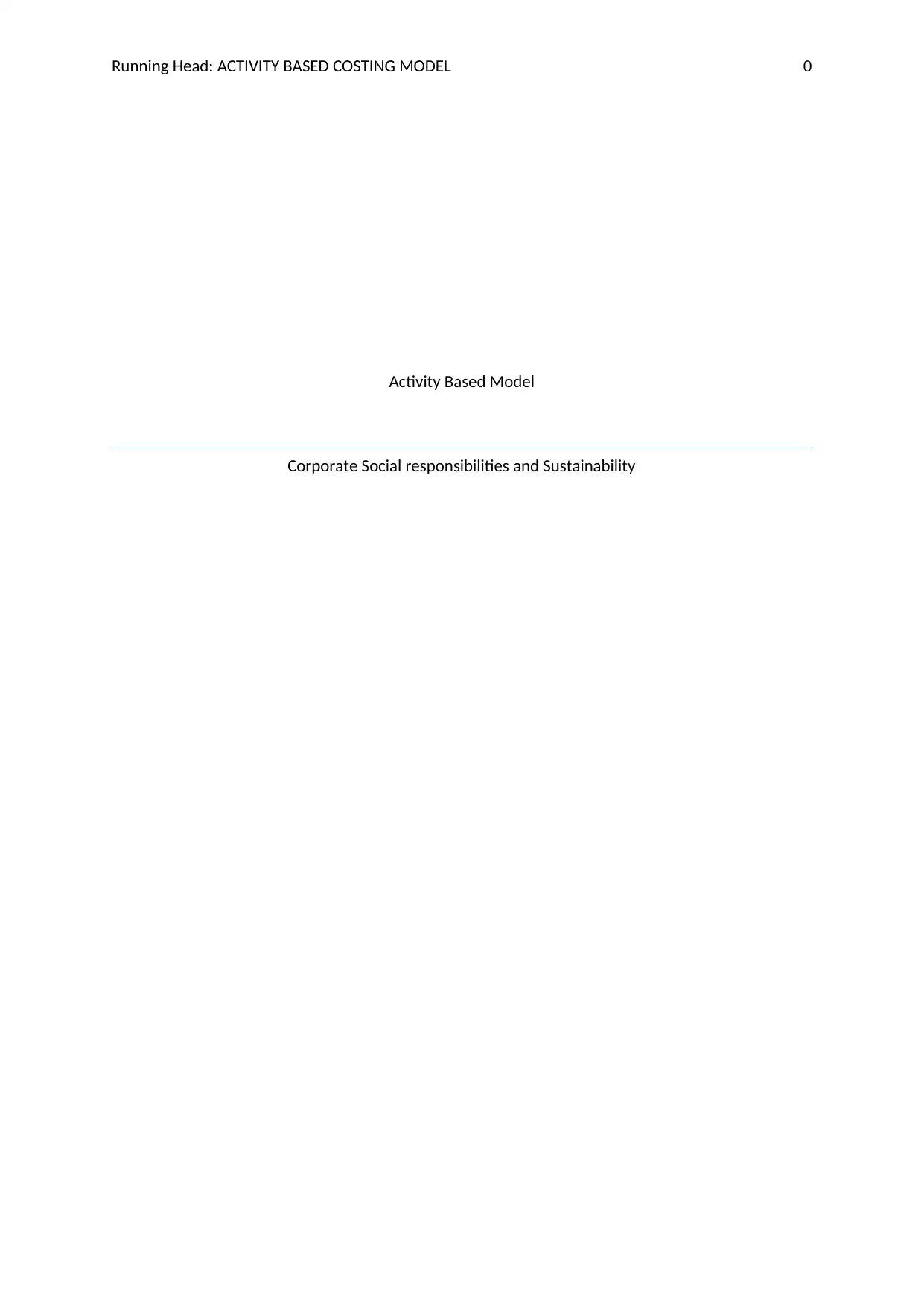
Running Head: ACTIVITY BASED COSTING MODEL 0
Activity Based Model
Corporate Social responsibilities and Sustainability
Activity Based Model
Corporate Social responsibilities and Sustainability
Paraphrase This Document
Need a fresh take? Get an instant paraphrase of this document with our AI Paraphraser
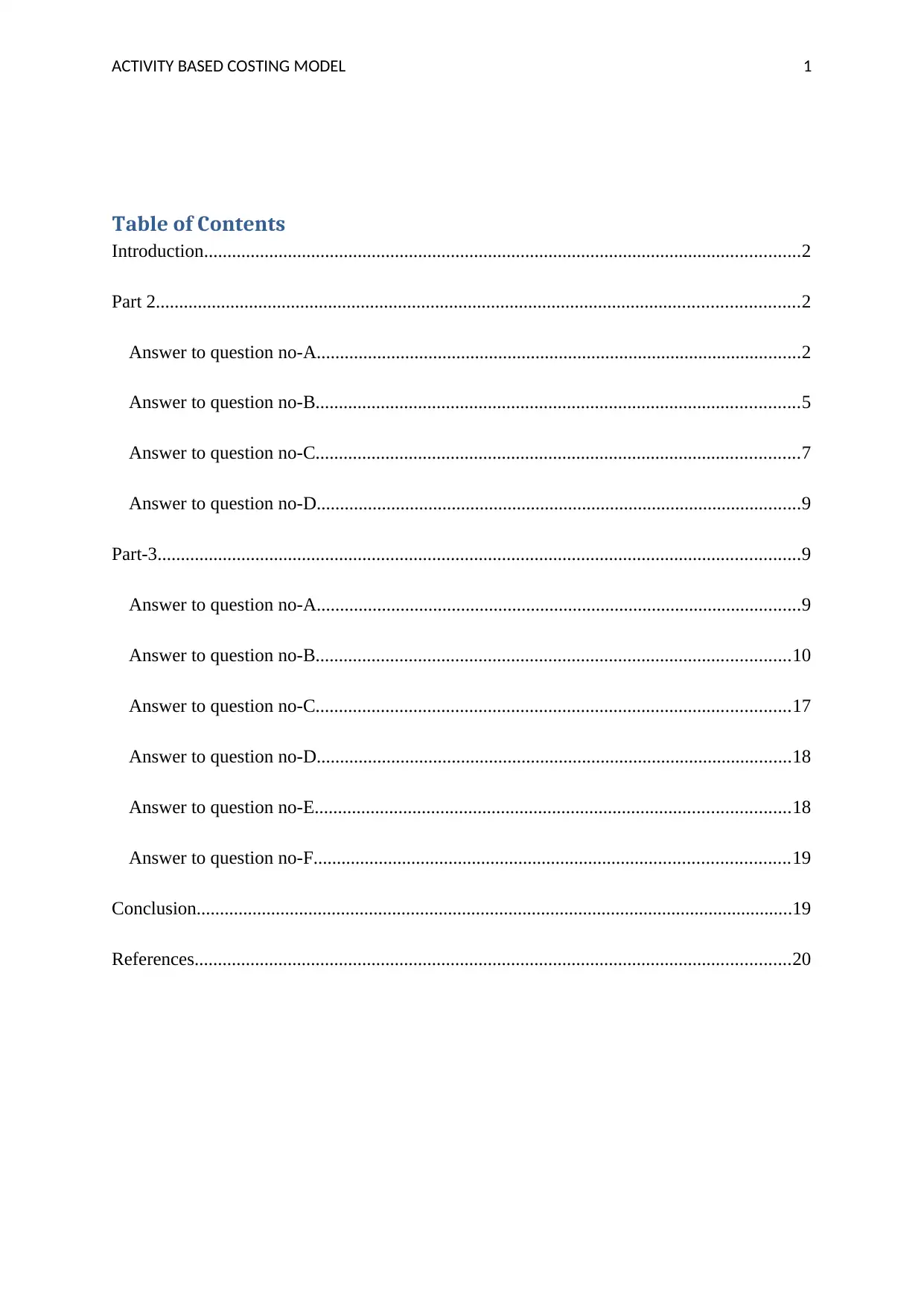
ACTIVITY BASED COSTING MODEL 1
Table of Contents
Introduction................................................................................................................................2
Part 2..........................................................................................................................................2
Answer to question no-A........................................................................................................2
Answer to question no-B........................................................................................................5
Answer to question no-C........................................................................................................7
Answer to question no-D........................................................................................................9
Part-3..........................................................................................................................................9
Answer to question no-A........................................................................................................9
Answer to question no-B......................................................................................................10
Answer to question no-C......................................................................................................17
Answer to question no-D......................................................................................................18
Answer to question no-E......................................................................................................18
Answer to question no-F......................................................................................................19
Conclusion................................................................................................................................19
References................................................................................................................................20
Table of Contents
Introduction................................................................................................................................2
Part 2..........................................................................................................................................2
Answer to question no-A........................................................................................................2
Answer to question no-B........................................................................................................5
Answer to question no-C........................................................................................................7
Answer to question no-D........................................................................................................9
Part-3..........................................................................................................................................9
Answer to question no-A........................................................................................................9
Answer to question no-B......................................................................................................10
Answer to question no-C......................................................................................................17
Answer to question no-D......................................................................................................18
Answer to question no-E......................................................................................................18
Answer to question no-F......................................................................................................19
Conclusion................................................................................................................................19
References................................................................................................................................20
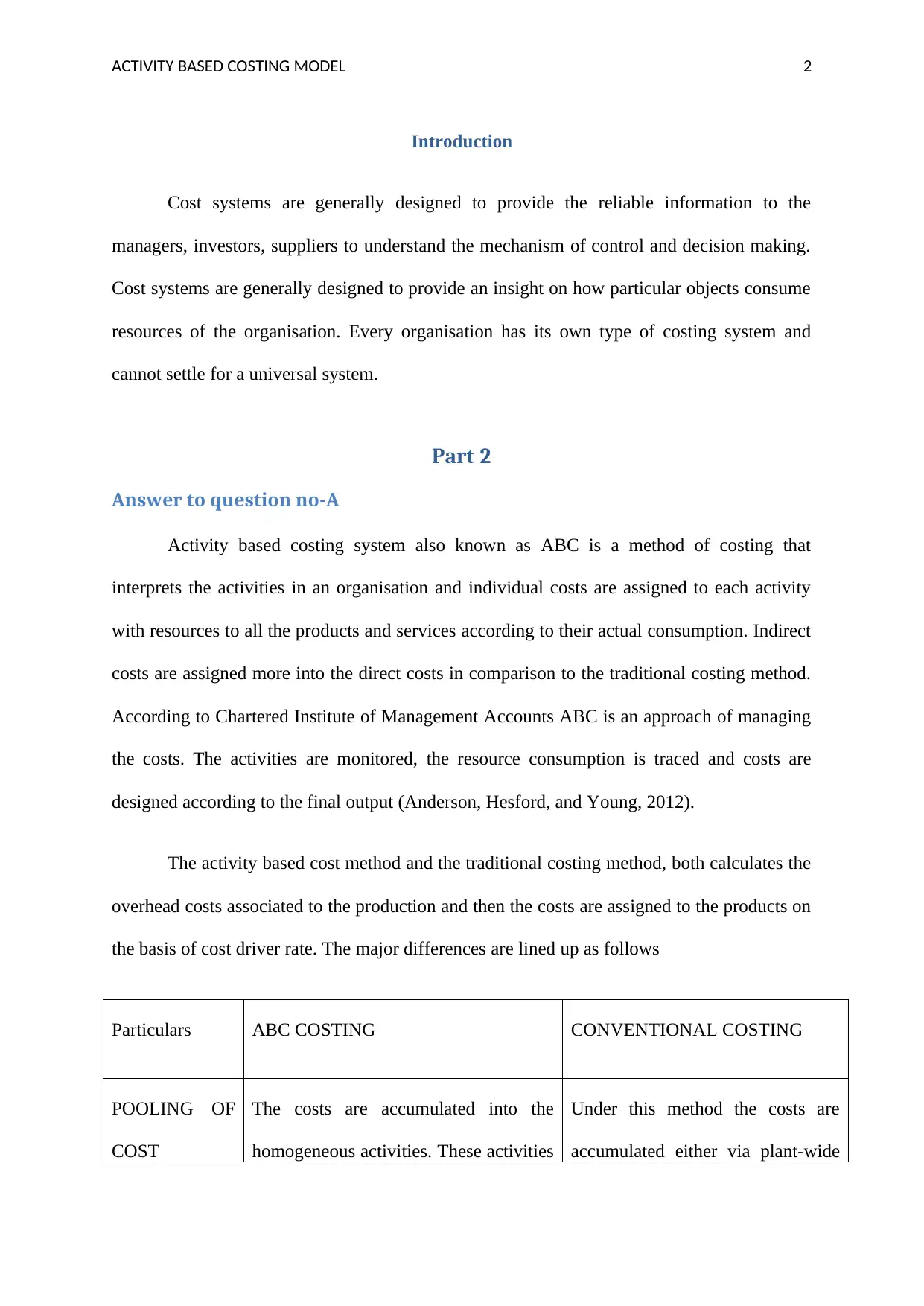
ACTIVITY BASED COSTING MODEL 2
Introduction
Cost systems are generally designed to provide the reliable information to the
managers, investors, suppliers to understand the mechanism of control and decision making.
Cost systems are generally designed to provide an insight on how particular objects consume
resources of the organisation. Every organisation has its own type of costing system and
cannot settle for a universal system.
Part 2
Answer to question no-A
Activity based costing system also known as ABC is a method of costing that
interprets the activities in an organisation and individual costs are assigned to each activity
with resources to all the products and services according to their actual consumption. Indirect
costs are assigned more into the direct costs in comparison to the traditional costing method.
According to Chartered Institute of Management Accounts ABC is an approach of managing
the costs. The activities are monitored, the resource consumption is traced and costs are
designed according to the final output (Anderson, Hesford, and Young, 2012).
The activity based cost method and the traditional costing method, both calculates the
overhead costs associated to the production and then the costs are assigned to the products on
the basis of cost driver rate. The major differences are lined up as follows
Particulars ABC COSTING CONVENTIONAL COSTING
POOLING OF
COST
The costs are accumulated into the
homogeneous activities. These activities
Under this method the costs are
accumulated either via plant-wide
Introduction
Cost systems are generally designed to provide the reliable information to the
managers, investors, suppliers to understand the mechanism of control and decision making.
Cost systems are generally designed to provide an insight on how particular objects consume
resources of the organisation. Every organisation has its own type of costing system and
cannot settle for a universal system.
Part 2
Answer to question no-A
Activity based costing system also known as ABC is a method of costing that
interprets the activities in an organisation and individual costs are assigned to each activity
with resources to all the products and services according to their actual consumption. Indirect
costs are assigned more into the direct costs in comparison to the traditional costing method.
According to Chartered Institute of Management Accounts ABC is an approach of managing
the costs. The activities are monitored, the resource consumption is traced and costs are
designed according to the final output (Anderson, Hesford, and Young, 2012).
The activity based cost method and the traditional costing method, both calculates the
overhead costs associated to the production and then the costs are assigned to the products on
the basis of cost driver rate. The major differences are lined up as follows
Particulars ABC COSTING CONVENTIONAL COSTING
POOLING OF
COST
The costs are accumulated into the
homogeneous activities. These activities
Under this method the costs are
accumulated either via plant-wide
You're viewing a preview
Unlock full access by subscribing today!
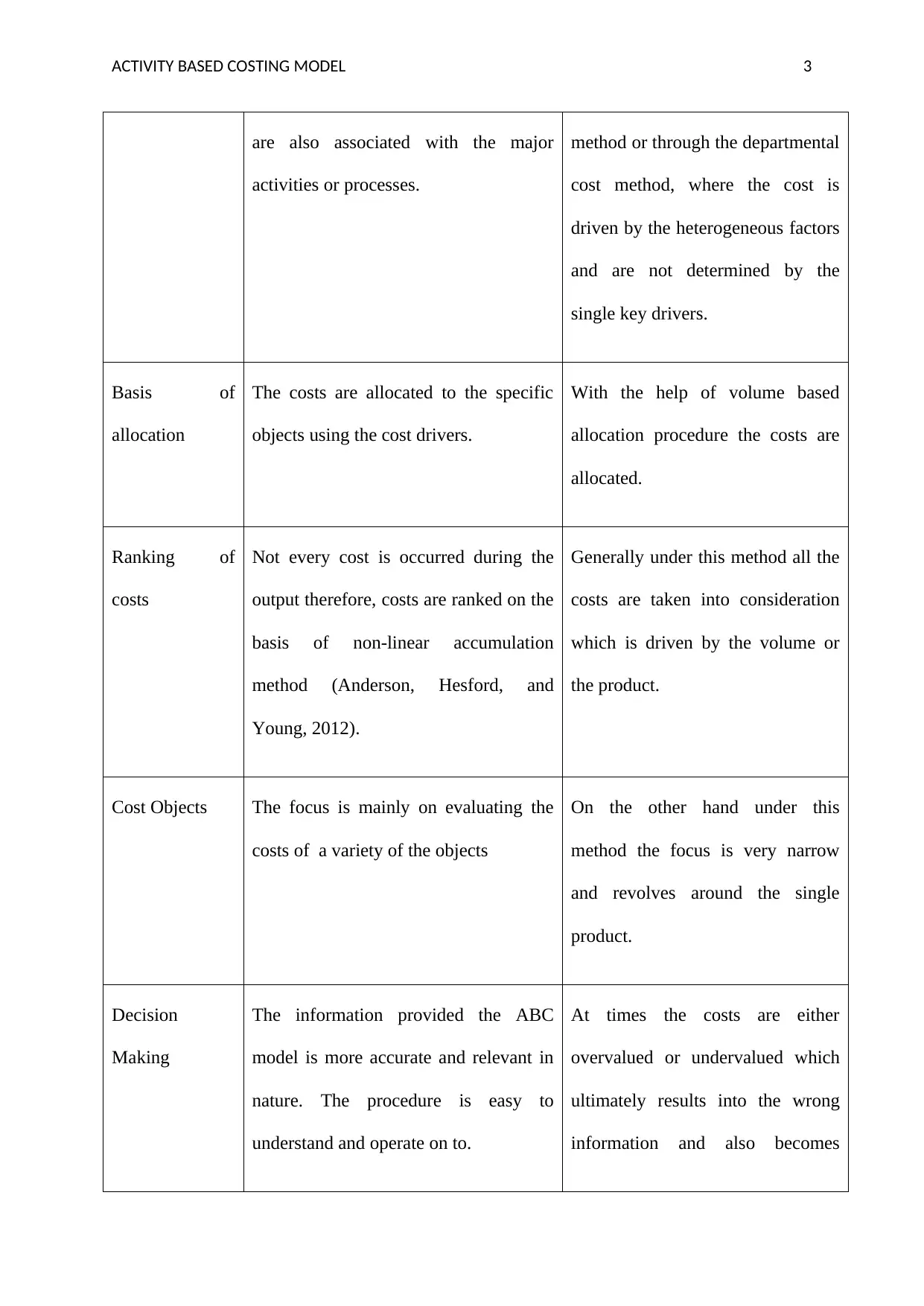
ACTIVITY BASED COSTING MODEL 3
are also associated with the major
activities or processes.
method or through the departmental
cost method, where the cost is
driven by the heterogeneous factors
and are not determined by the
single key drivers.
Basis of
allocation
The costs are allocated to the specific
objects using the cost drivers.
With the help of volume based
allocation procedure the costs are
allocated.
Ranking of
costs
Not every cost is occurred during the
output therefore, costs are ranked on the
basis of non-linear accumulation
method (Anderson, Hesford, and
Young, 2012).
Generally under this method all the
costs are taken into consideration
which is driven by the volume or
the product.
Cost Objects The focus is mainly on evaluating the
costs of a variety of the objects
On the other hand under this
method the focus is very narrow
and revolves around the single
product.
Decision
Making
The information provided the ABC
model is more accurate and relevant in
nature. The procedure is easy to
understand and operate on to.
At times the costs are either
overvalued or undervalued which
ultimately results into the wrong
information and also becomes
are also associated with the major
activities or processes.
method or through the departmental
cost method, where the cost is
driven by the heterogeneous factors
and are not determined by the
single key drivers.
Basis of
allocation
The costs are allocated to the specific
objects using the cost drivers.
With the help of volume based
allocation procedure the costs are
allocated.
Ranking of
costs
Not every cost is occurred during the
output therefore, costs are ranked on the
basis of non-linear accumulation
method (Anderson, Hesford, and
Young, 2012).
Generally under this method all the
costs are taken into consideration
which is driven by the volume or
the product.
Cost Objects The focus is mainly on evaluating the
costs of a variety of the objects
On the other hand under this
method the focus is very narrow
and revolves around the single
product.
Decision
Making
The information provided the ABC
model is more accurate and relevant in
nature. The procedure is easy to
understand and operate on to.
At times the costs are either
overvalued or undervalued which
ultimately results into the wrong
information and also becomes
Paraphrase This Document
Need a fresh take? Get an instant paraphrase of this document with our AI Paraphraser
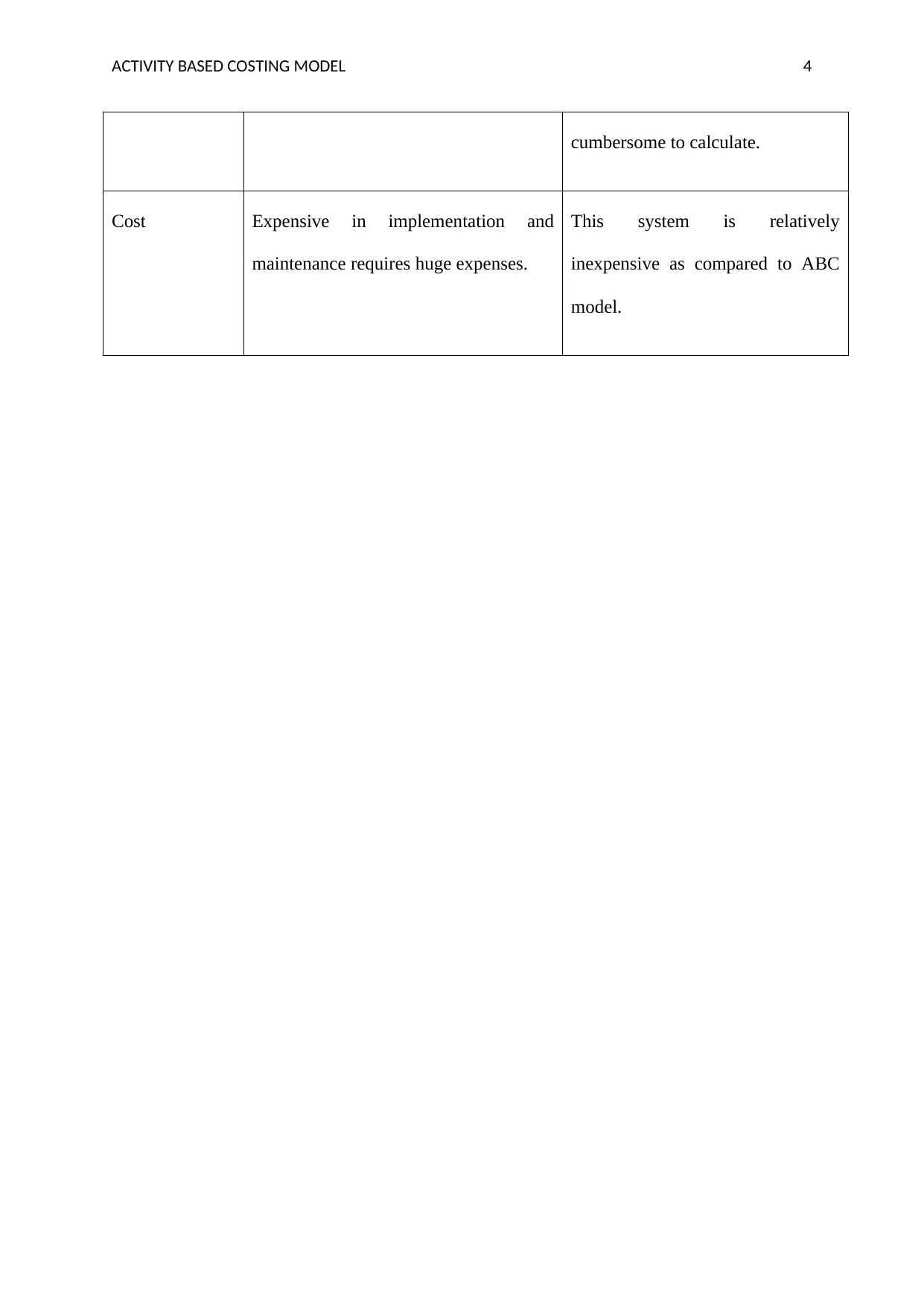
ACTIVITY BASED COSTING MODEL 4
cumbersome to calculate.
Cost Expensive in implementation and
maintenance requires huge expenses.
This system is relatively
inexpensive as compared to ABC
model.
cumbersome to calculate.
Cost Expensive in implementation and
maintenance requires huge expenses.
This system is relatively
inexpensive as compared to ABC
model.
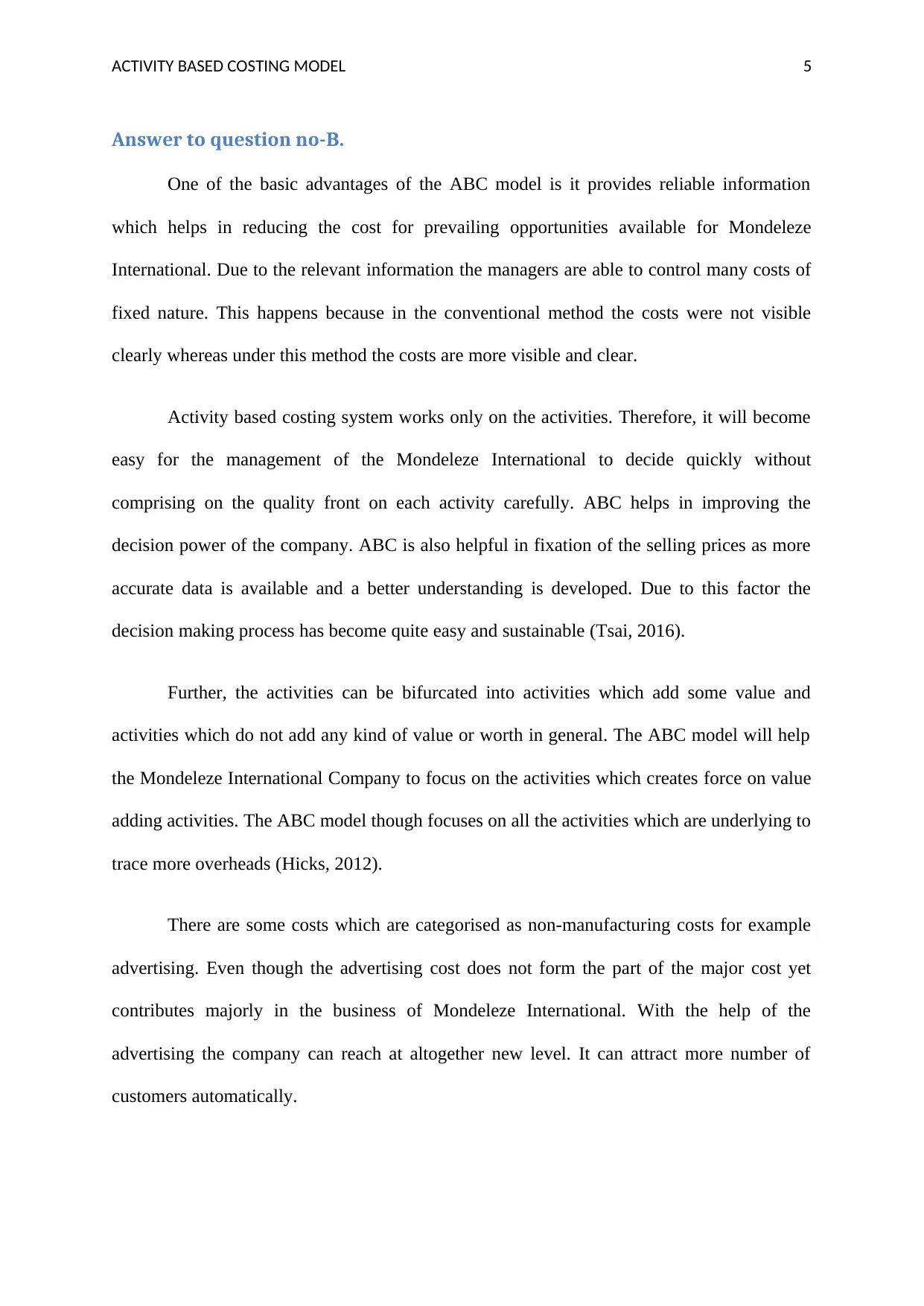
ACTIVITY BASED COSTING MODEL 5
Answer to question no-B.
One of the basic advantages of the ABC model is it provides reliable information
which helps in reducing the cost for prevailing opportunities available for Mondeleze
International. Due to the relevant information the managers are able to control many costs of
fixed nature. This happens because in the conventional method the costs were not visible
clearly whereas under this method the costs are more visible and clear.
Activity based costing system works only on the activities. Therefore, it will become
easy for the management of the Mondeleze International to decide quickly without
comprising on the quality front on each activity carefully. ABC helps in improving the
decision power of the company. ABC is also helpful in fixation of the selling prices as more
accurate data is available and a better understanding is developed. Due to this factor the
decision making process has become quite easy and sustainable (Tsai, 2016).
Further, the activities can be bifurcated into activities which add some value and
activities which do not add any kind of value or worth in general. The ABC model will help
the Mondeleze International Company to focus on the activities which creates force on value
adding activities. The ABC model though focuses on all the activities which are underlying to
trace more overheads (Hicks, 2012).
There are some costs which are categorised as non-manufacturing costs for example
advertising. Even though the advertising cost does not form the part of the major cost yet
contributes majorly in the business of Mondeleze International. With the help of the
advertising the company can reach at altogether new level. It can attract more number of
customers automatically.
Answer to question no-B.
One of the basic advantages of the ABC model is it provides reliable information
which helps in reducing the cost for prevailing opportunities available for Mondeleze
International. Due to the relevant information the managers are able to control many costs of
fixed nature. This happens because in the conventional method the costs were not visible
clearly whereas under this method the costs are more visible and clear.
Activity based costing system works only on the activities. Therefore, it will become
easy for the management of the Mondeleze International to decide quickly without
comprising on the quality front on each activity carefully. ABC helps in improving the
decision power of the company. ABC is also helpful in fixation of the selling prices as more
accurate data is available and a better understanding is developed. Due to this factor the
decision making process has become quite easy and sustainable (Tsai, 2016).
Further, the activities can be bifurcated into activities which add some value and
activities which do not add any kind of value or worth in general. The ABC model will help
the Mondeleze International Company to focus on the activities which creates force on value
adding activities. The ABC model though focuses on all the activities which are underlying to
trace more overheads (Hicks, 2012).
There are some costs which are categorised as non-manufacturing costs for example
advertising. Even though the advertising cost does not form the part of the major cost yet
contributes majorly in the business of Mondeleze International. With the help of the
advertising the company can reach at altogether new level. It can attract more number of
customers automatically.
You're viewing a preview
Unlock full access by subscribing today!
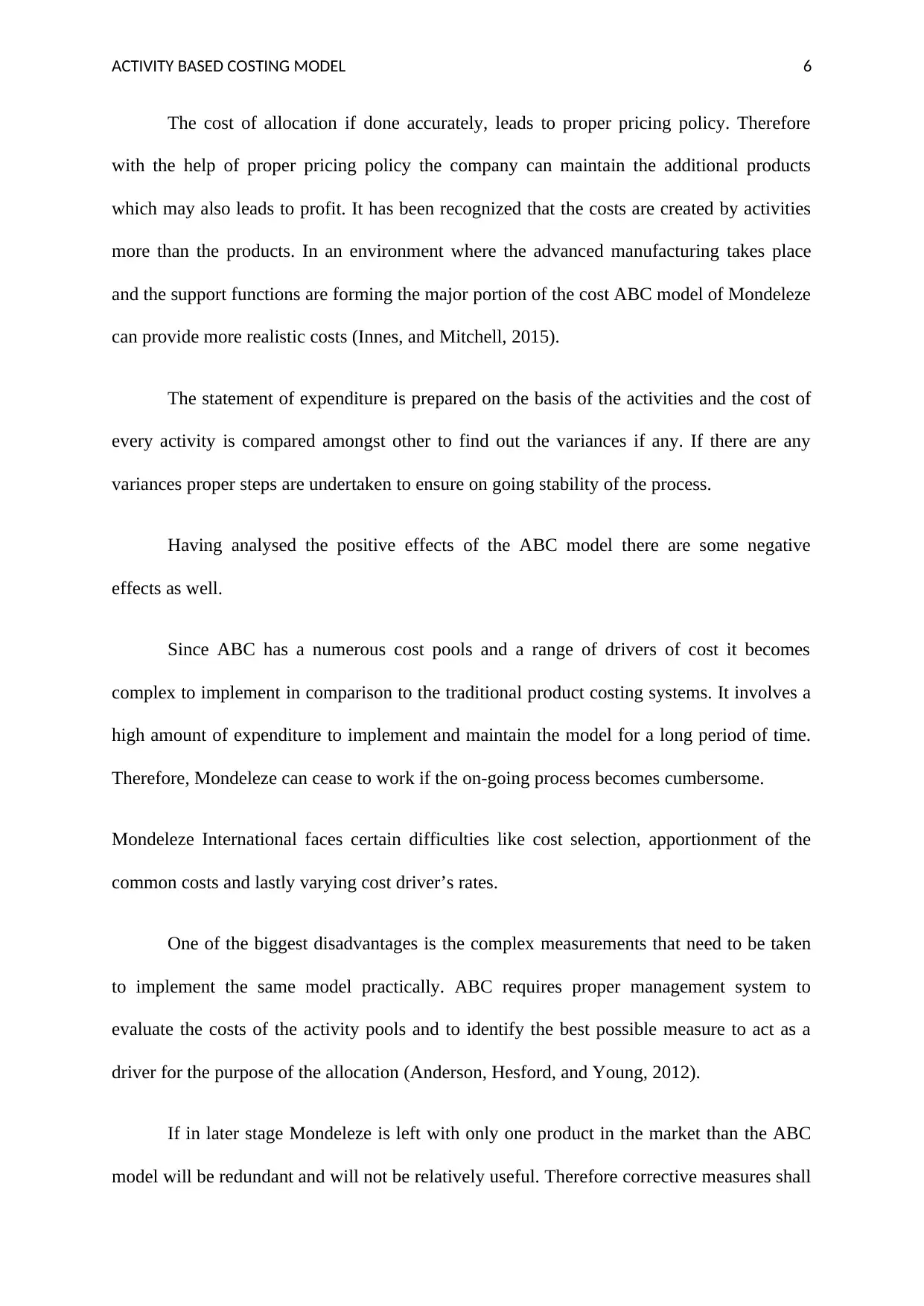
ACTIVITY BASED COSTING MODEL 6
The cost of allocation if done accurately, leads to proper pricing policy. Therefore
with the help of proper pricing policy the company can maintain the additional products
which may also leads to profit. It has been recognized that the costs are created by activities
more than the products. In an environment where the advanced manufacturing takes place
and the support functions are forming the major portion of the cost ABC model of Mondeleze
can provide more realistic costs (Innes, and Mitchell, 2015).
The statement of expenditure is prepared on the basis of the activities and the cost of
every activity is compared amongst other to find out the variances if any. If there are any
variances proper steps are undertaken to ensure on going stability of the process.
Having analysed the positive effects of the ABC model there are some negative
effects as well.
Since ABC has a numerous cost pools and a range of drivers of cost it becomes
complex to implement in comparison to the traditional product costing systems. It involves a
high amount of expenditure to implement and maintain the model for a long period of time.
Therefore, Mondeleze can cease to work if the on-going process becomes cumbersome.
Mondeleze International faces certain difficulties like cost selection, apportionment of the
common costs and lastly varying cost driver’s rates.
One of the biggest disadvantages is the complex measurements that need to be taken
to implement the same model practically. ABC requires proper management system to
evaluate the costs of the activity pools and to identify the best possible measure to act as a
driver for the purpose of the allocation (Anderson, Hesford, and Young, 2012).
If in later stage Mondeleze is left with only one product in the market than the ABC
model will be redundant and will not be relatively useful. Therefore corrective measures shall
The cost of allocation if done accurately, leads to proper pricing policy. Therefore
with the help of proper pricing policy the company can maintain the additional products
which may also leads to profit. It has been recognized that the costs are created by activities
more than the products. In an environment where the advanced manufacturing takes place
and the support functions are forming the major portion of the cost ABC model of Mondeleze
can provide more realistic costs (Innes, and Mitchell, 2015).
The statement of expenditure is prepared on the basis of the activities and the cost of
every activity is compared amongst other to find out the variances if any. If there are any
variances proper steps are undertaken to ensure on going stability of the process.
Having analysed the positive effects of the ABC model there are some negative
effects as well.
Since ABC has a numerous cost pools and a range of drivers of cost it becomes
complex to implement in comparison to the traditional product costing systems. It involves a
high amount of expenditure to implement and maintain the model for a long period of time.
Therefore, Mondeleze can cease to work if the on-going process becomes cumbersome.
Mondeleze International faces certain difficulties like cost selection, apportionment of the
common costs and lastly varying cost driver’s rates.
One of the biggest disadvantages is the complex measurements that need to be taken
to implement the same model practically. ABC requires proper management system to
evaluate the costs of the activity pools and to identify the best possible measure to act as a
driver for the purpose of the allocation (Anderson, Hesford, and Young, 2012).
If in later stage Mondeleze is left with only one product in the market than the ABC
model will be redundant and will not be relatively useful. Therefore corrective measures shall
Paraphrase This Document
Need a fresh take? Get an instant paraphrase of this document with our AI Paraphraser
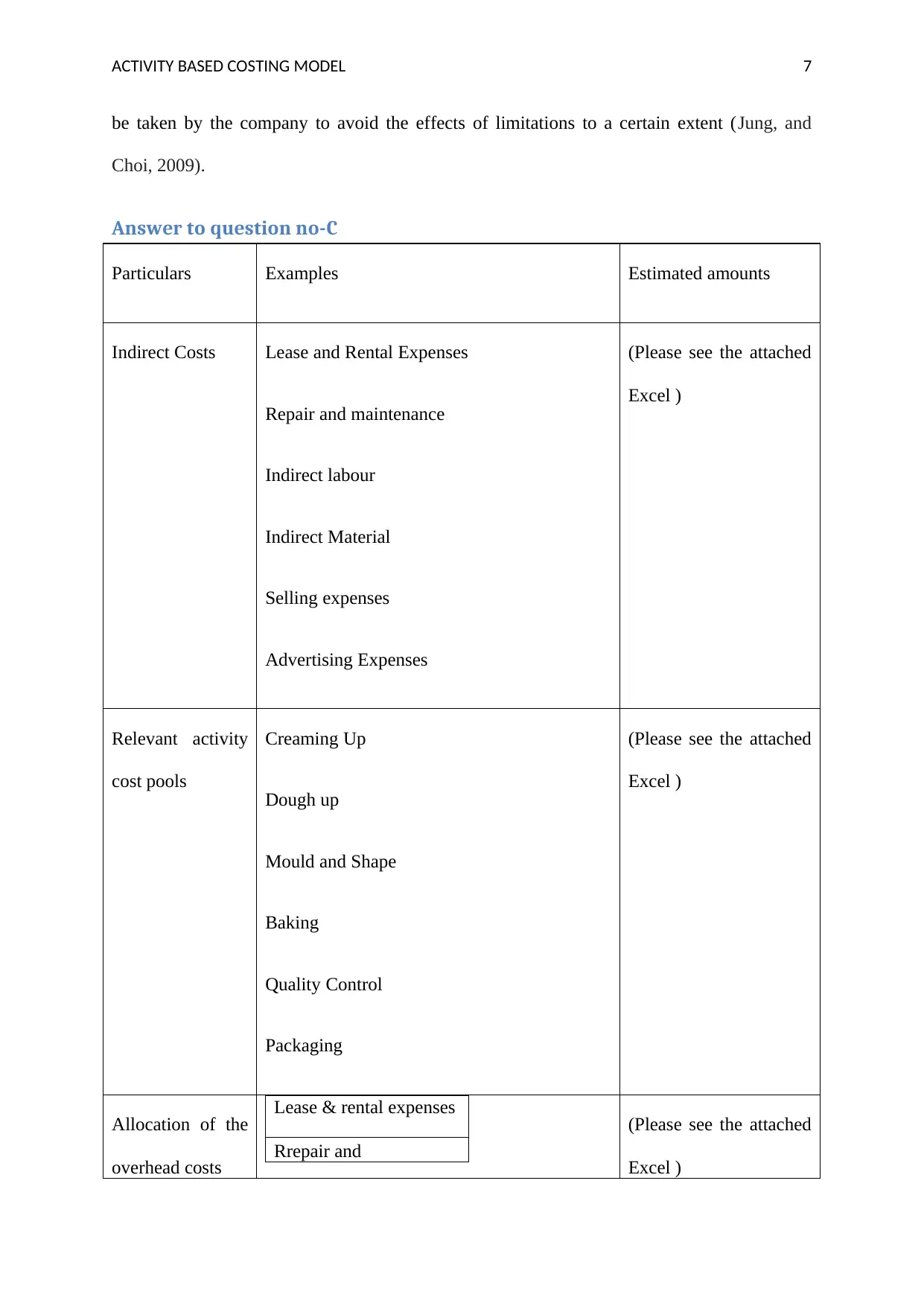
ACTIVITY BASED COSTING MODEL 7
be taken by the company to avoid the effects of limitations to a certain extent (Jung, and
Choi, 2009).
Answer to question no-C
Particulars Examples Estimated amounts
Indirect Costs Lease and Rental Expenses
Repair and maintenance
Indirect labour
Indirect Material
Selling expenses
Advertising Expenses
(Please see the attached
Excel )
Relevant activity
cost pools
Creaming Up
Dough up
Mould and Shape
Baking
Quality Control
Packaging
(Please see the attached
Excel )
Allocation of the
overhead costs
Lease & rental expenses
Rrepair and
(Please see the attached
Excel )
be taken by the company to avoid the effects of limitations to a certain extent (Jung, and
Choi, 2009).
Answer to question no-C
Particulars Examples Estimated amounts
Indirect Costs Lease and Rental Expenses
Repair and maintenance
Indirect labour
Indirect Material
Selling expenses
Advertising Expenses
(Please see the attached
Excel )
Relevant activity
cost pools
Creaming Up
Dough up
Mould and Shape
Baking
Quality Control
Packaging
(Please see the attached
Excel )
Allocation of the
overhead costs
Lease & rental expenses
Rrepair and
(Please see the attached
Excel )
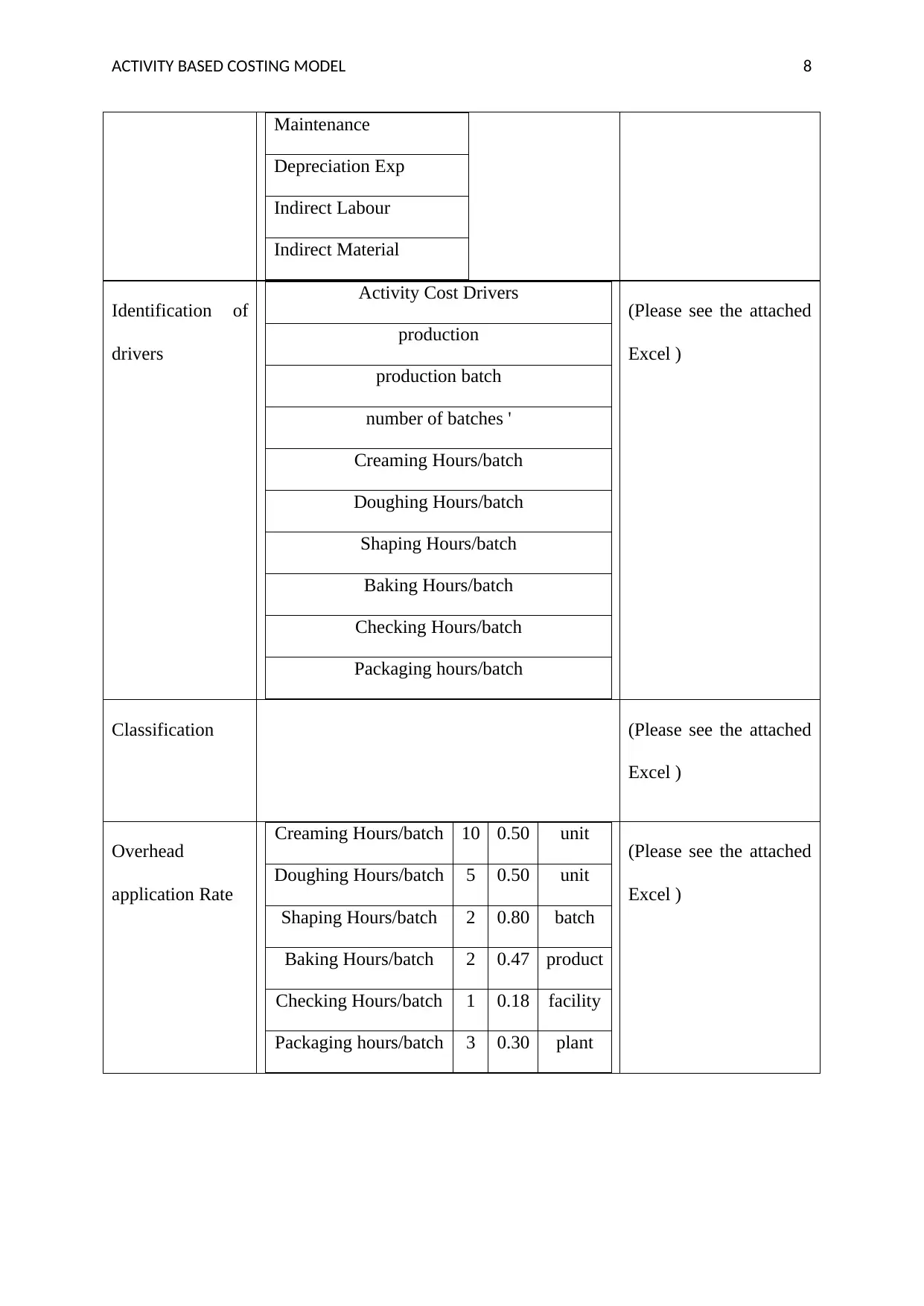
ACTIVITY BASED COSTING MODEL 8
Maintenance
Depreciation Exp
Indirect Labour
Indirect Material
Identification of
drivers
Activity Cost Drivers
production
production batch
number of batches '
Creaming Hours/batch
Doughing Hours/batch
Shaping Hours/batch
Baking Hours/batch
Checking Hours/batch
Packaging hours/batch
(Please see the attached
Excel )
Classification (Please see the attached
Excel )
Overhead
application Rate
Creaming Hours/batch 10 0.50 unit
Doughing Hours/batch 5 0.50 unit
Shaping Hours/batch 2 0.80 batch
Baking Hours/batch 2 0.47 product
Checking Hours/batch 1 0.18 facility
Packaging hours/batch 3 0.30 plant
(Please see the attached
Excel )
Maintenance
Depreciation Exp
Indirect Labour
Indirect Material
Identification of
drivers
Activity Cost Drivers
production
production batch
number of batches '
Creaming Hours/batch
Doughing Hours/batch
Shaping Hours/batch
Baking Hours/batch
Checking Hours/batch
Packaging hours/batch
(Please see the attached
Excel )
Classification (Please see the attached
Excel )
Overhead
application Rate
Creaming Hours/batch 10 0.50 unit
Doughing Hours/batch 5 0.50 unit
Shaping Hours/batch 2 0.80 batch
Baking Hours/batch 2 0.47 product
Checking Hours/batch 1 0.18 facility
Packaging hours/batch 3 0.30 plant
(Please see the attached
Excel )
You're viewing a preview
Unlock full access by subscribing today!
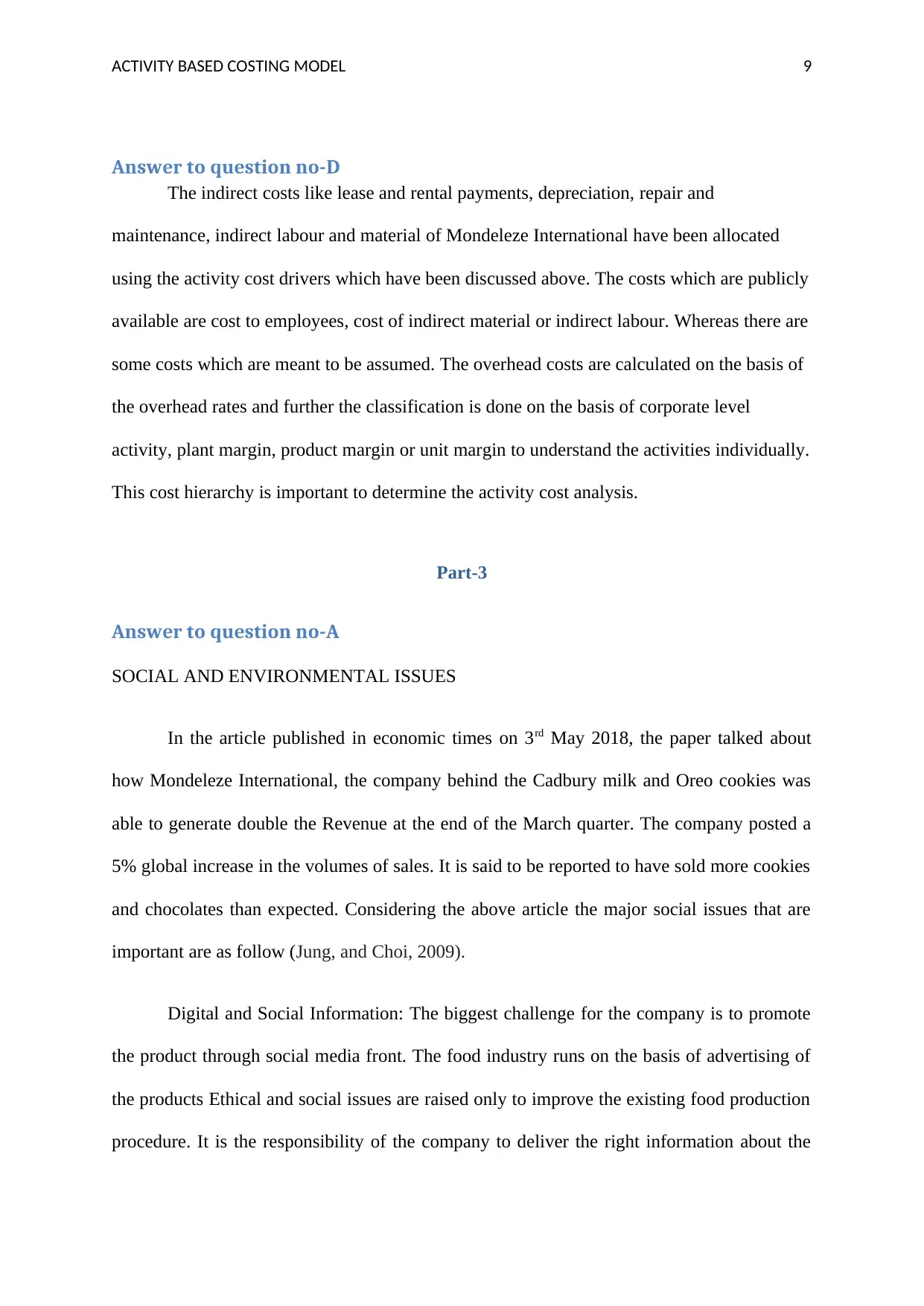
ACTIVITY BASED COSTING MODEL 9
Answer to question no-D
The indirect costs like lease and rental payments, depreciation, repair and
maintenance, indirect labour and material of Mondeleze International have been allocated
using the activity cost drivers which have been discussed above. The costs which are publicly
available are cost to employees, cost of indirect material or indirect labour. Whereas there are
some costs which are meant to be assumed. The overhead costs are calculated on the basis of
the overhead rates and further the classification is done on the basis of corporate level
activity, plant margin, product margin or unit margin to understand the activities individually.
This cost hierarchy is important to determine the activity cost analysis.
Part-3
Answer to question no-A
SOCIAL AND ENVIRONMENTAL ISSUES
In the article published in economic times on 3rd May 2018, the paper talked about
how Mondeleze International, the company behind the Cadbury milk and Oreo cookies was
able to generate double the Revenue at the end of the March quarter. The company posted a
5% global increase in the volumes of sales. It is said to be reported to have sold more cookies
and chocolates than expected. Considering the above article the major social issues that are
important are as follow (Jung, and Choi, 2009).
Digital and Social Information: The biggest challenge for the company is to promote
the product through social media front. The food industry runs on the basis of advertising of
the products Ethical and social issues are raised only to improve the existing food production
procedure. It is the responsibility of the company to deliver the right information about the
Answer to question no-D
The indirect costs like lease and rental payments, depreciation, repair and
maintenance, indirect labour and material of Mondeleze International have been allocated
using the activity cost drivers which have been discussed above. The costs which are publicly
available are cost to employees, cost of indirect material or indirect labour. Whereas there are
some costs which are meant to be assumed. The overhead costs are calculated on the basis of
the overhead rates and further the classification is done on the basis of corporate level
activity, plant margin, product margin or unit margin to understand the activities individually.
This cost hierarchy is important to determine the activity cost analysis.
Part-3
Answer to question no-A
SOCIAL AND ENVIRONMENTAL ISSUES
In the article published in economic times on 3rd May 2018, the paper talked about
how Mondeleze International, the company behind the Cadbury milk and Oreo cookies was
able to generate double the Revenue at the end of the March quarter. The company posted a
5% global increase in the volumes of sales. It is said to be reported to have sold more cookies
and chocolates than expected. Considering the above article the major social issues that are
important are as follow (Jung, and Choi, 2009).
Digital and Social Information: The biggest challenge for the company is to promote
the product through social media front. The food industry runs on the basis of advertising of
the products Ethical and social issues are raised only to improve the existing food production
procedure. It is the responsibility of the company to deliver the right information about the
Paraphrase This Document
Need a fresh take? Get an instant paraphrase of this document with our AI Paraphraser
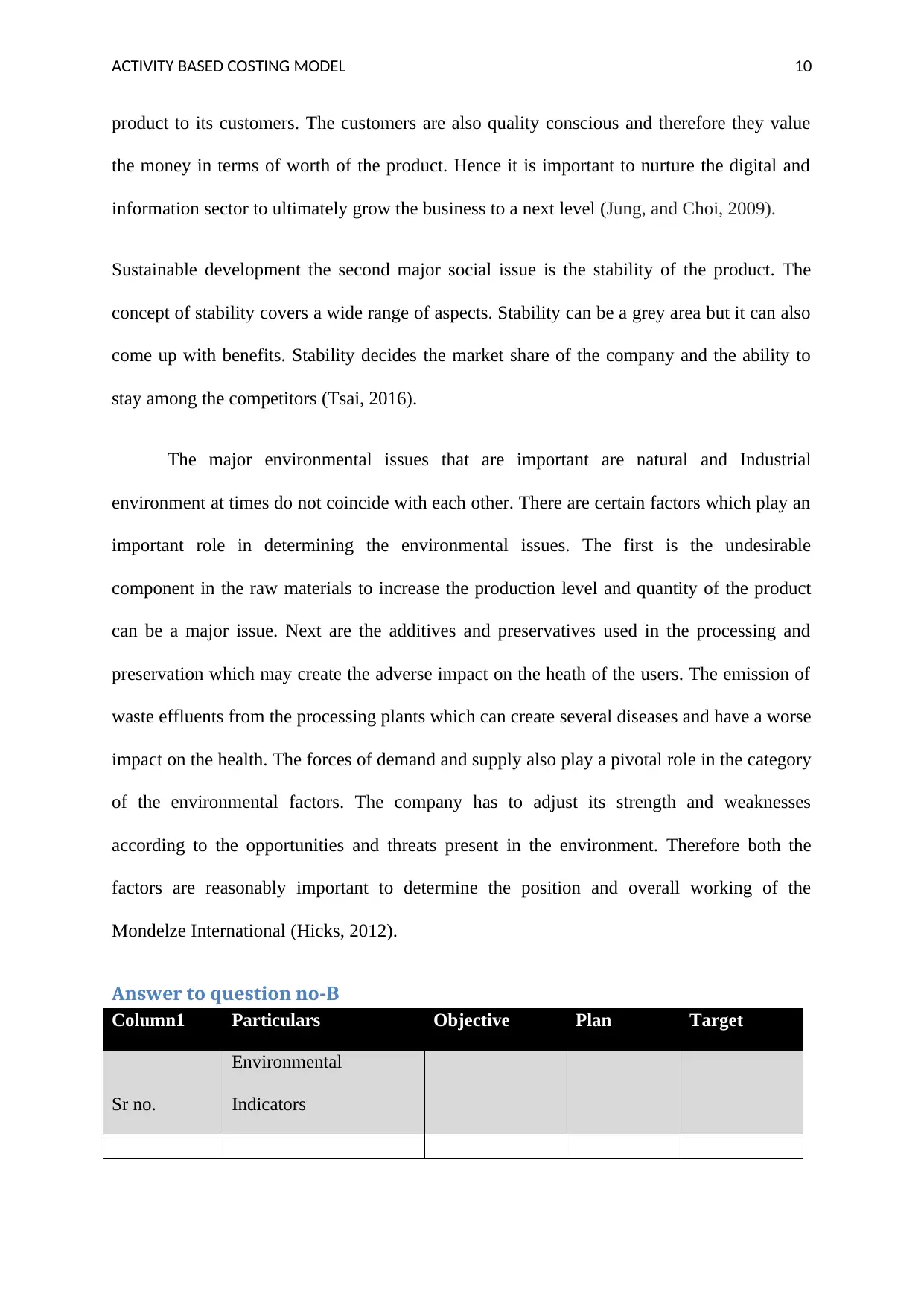
ACTIVITY BASED COSTING MODEL 10
product to its customers. The customers are also quality conscious and therefore they value
the money in terms of worth of the product. Hence it is important to nurture the digital and
information sector to ultimately grow the business to a next level (Jung, and Choi, 2009).
Sustainable development the second major social issue is the stability of the product. The
concept of stability covers a wide range of aspects. Stability can be a grey area but it can also
come up with benefits. Stability decides the market share of the company and the ability to
stay among the competitors (Tsai, 2016).
The major environmental issues that are important are natural and Industrial
environment at times do not coincide with each other. There are certain factors which play an
important role in determining the environmental issues. The first is the undesirable
component in the raw materials to increase the production level and quantity of the product
can be a major issue. Next are the additives and preservatives used in the processing and
preservation which may create the adverse impact on the heath of the users. The emission of
waste effluents from the processing plants which can create several diseases and have a worse
impact on the health. The forces of demand and supply also play a pivotal role in the category
of the environmental factors. The company has to adjust its strength and weaknesses
according to the opportunities and threats present in the environment. Therefore both the
factors are reasonably important to determine the position and overall working of the
Mondelze International (Hicks, 2012).
Answer to question no-B
Column1 Particulars Objective Plan Target
Sr no.
Environmental
Indicators
product to its customers. The customers are also quality conscious and therefore they value
the money in terms of worth of the product. Hence it is important to nurture the digital and
information sector to ultimately grow the business to a next level (Jung, and Choi, 2009).
Sustainable development the second major social issue is the stability of the product. The
concept of stability covers a wide range of aspects. Stability can be a grey area but it can also
come up with benefits. Stability decides the market share of the company and the ability to
stay among the competitors (Tsai, 2016).
The major environmental issues that are important are natural and Industrial
environment at times do not coincide with each other. There are certain factors which play an
important role in determining the environmental issues. The first is the undesirable
component in the raw materials to increase the production level and quantity of the product
can be a major issue. Next are the additives and preservatives used in the processing and
preservation which may create the adverse impact on the heath of the users. The emission of
waste effluents from the processing plants which can create several diseases and have a worse
impact on the health. The forces of demand and supply also play a pivotal role in the category
of the environmental factors. The company has to adjust its strength and weaknesses
according to the opportunities and threats present in the environment. Therefore both the
factors are reasonably important to determine the position and overall working of the
Mondelze International (Hicks, 2012).
Answer to question no-B
Column1 Particulars Objective Plan Target
Sr no.
Environmental
Indicators
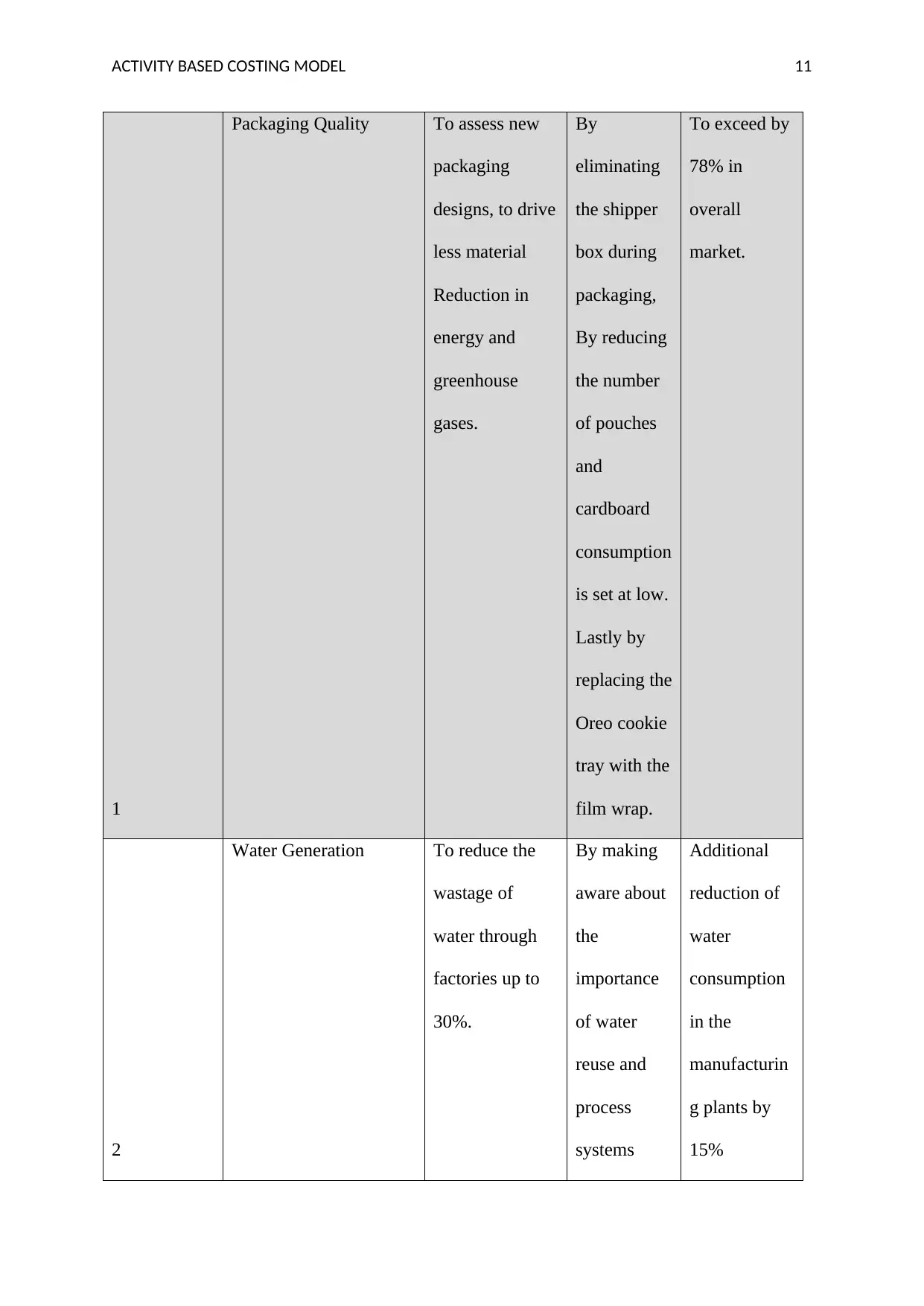
ACTIVITY BASED COSTING MODEL 11
1
Packaging Quality To assess new
packaging
designs, to drive
less material
Reduction in
energy and
greenhouse
gases.
By
eliminating
the shipper
box during
packaging,
By reducing
the number
of pouches
and
cardboard
consumption
is set at low.
Lastly by
replacing the
Oreo cookie
tray with the
film wrap.
To exceed by
78% in
overall
market.
2
Water Generation To reduce the
wastage of
water through
factories up to
30%.
By making
aware about
the
importance
of water
reuse and
process
systems
Additional
reduction of
water
consumption
in the
manufacturin
g plants by
15%
1
Packaging Quality To assess new
packaging
designs, to drive
less material
Reduction in
energy and
greenhouse
gases.
By
eliminating
the shipper
box during
packaging,
By reducing
the number
of pouches
and
cardboard
consumption
is set at low.
Lastly by
replacing the
Oreo cookie
tray with the
film wrap.
To exceed by
78% in
overall
market.
2
Water Generation To reduce the
wastage of
water through
factories up to
30%.
By making
aware about
the
importance
of water
reuse and
process
systems
Additional
reduction of
water
consumption
in the
manufacturin
g plants by
15%
You're viewing a preview
Unlock full access by subscribing today!
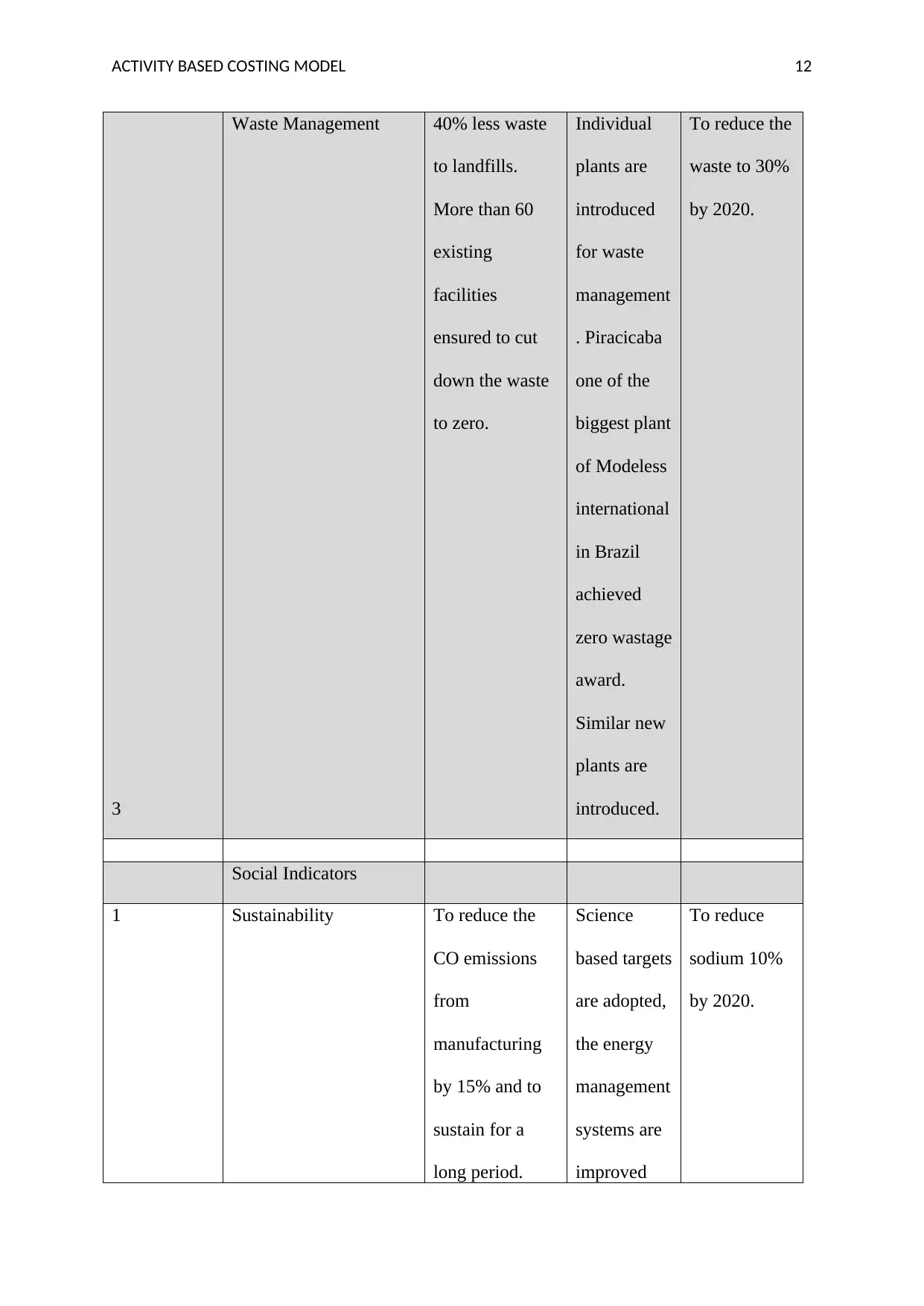
ACTIVITY BASED COSTING MODEL 12
3
Waste Management 40% less waste
to landfills.
More than 60
existing
facilities
ensured to cut
down the waste
to zero.
Individual
plants are
introduced
for waste
management
. Piracicaba
one of the
biggest plant
of Modeless
international
in Brazil
achieved
zero wastage
award.
Similar new
plants are
introduced.
To reduce the
waste to 30%
by 2020.
Social Indicators
1 Sustainability To reduce the
CO emissions
from
manufacturing
by 15% and to
sustain for a
long period.
Science
based targets
are adopted,
the energy
management
systems are
improved
To reduce
sodium 10%
by 2020.
3
Waste Management 40% less waste
to landfills.
More than 60
existing
facilities
ensured to cut
down the waste
to zero.
Individual
plants are
introduced
for waste
management
. Piracicaba
one of the
biggest plant
of Modeless
international
in Brazil
achieved
zero wastage
award.
Similar new
plants are
introduced.
To reduce the
waste to 30%
by 2020.
Social Indicators
1 Sustainability To reduce the
CO emissions
from
manufacturing
by 15% and to
sustain for a
long period.
Science
based targets
are adopted,
the energy
management
systems are
improved
To reduce
sodium 10%
by 2020.
Paraphrase This Document
Need a fresh take? Get an instant paraphrase of this document with our AI Paraphraser

ACTIVITY BASED COSTING MODEL 13
and using
renewable
sources of
energy
2 Well Being Snacks
To reach a wide
range of
customers and
to deliver the
best service
while ensuring
the health and
balance in life.
Complying
with the
marketing
and the
compliance
policy the
company is
engaged in
the number
of global
programs.
To expand 10
existing
wellbeing
brands in our
portfolio,
renovate and
improve the
nutrition and
to inspire the
consumers
and to cater
15% revenue.
3 Health and safety To ensure the
safety of the
employees
working in
Modeless
International, To
produce safe
quality products
((Briers, and
Through on-
going
educational
efforts,
enhanced
teamwork
and protocol
the company
have been
To produce
supplier
certified
products, and
to achieve a
30%
incidental
rate for all
employees by
and using
renewable
sources of
energy
2 Well Being Snacks
To reach a wide
range of
customers and
to deliver the
best service
while ensuring
the health and
balance in life.
Complying
with the
marketing
and the
compliance
policy the
company is
engaged in
the number
of global
programs.
To expand 10
existing
wellbeing
brands in our
portfolio,
renovate and
improve the
nutrition and
to inspire the
consumers
and to cater
15% revenue.
3 Health and safety To ensure the
safety of the
employees
working in
Modeless
International, To
produce safe
quality products
((Briers, and
Through on-
going
educational
efforts,
enhanced
teamwork
and protocol
the company
have been
To produce
supplier
certified
products, and
to achieve a
30%
incidental
rate for all
employees by
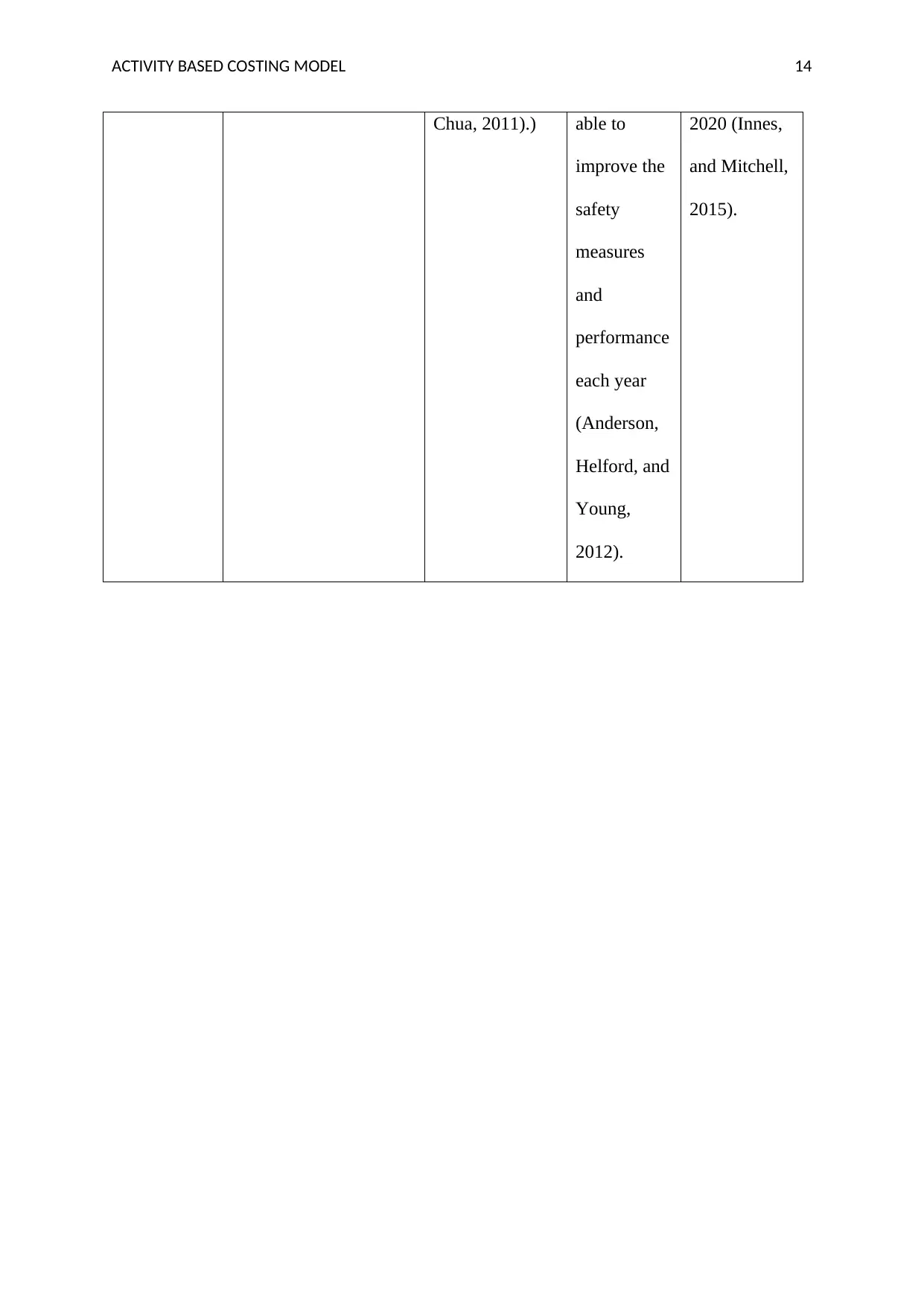
ACTIVITY BASED COSTING MODEL 14
Chua, 2011).) able to
improve the
safety
measures
and
performance
each year
(Anderson,
Helford, and
Young,
2012).
2020 (Innes,
and Mitchell,
2015).
Chua, 2011).) able to
improve the
safety
measures
and
performance
each year
(Anderson,
Helford, and
Young,
2012).
2020 (Innes,
and Mitchell,
2015).
You're viewing a preview
Unlock full access by subscribing today!
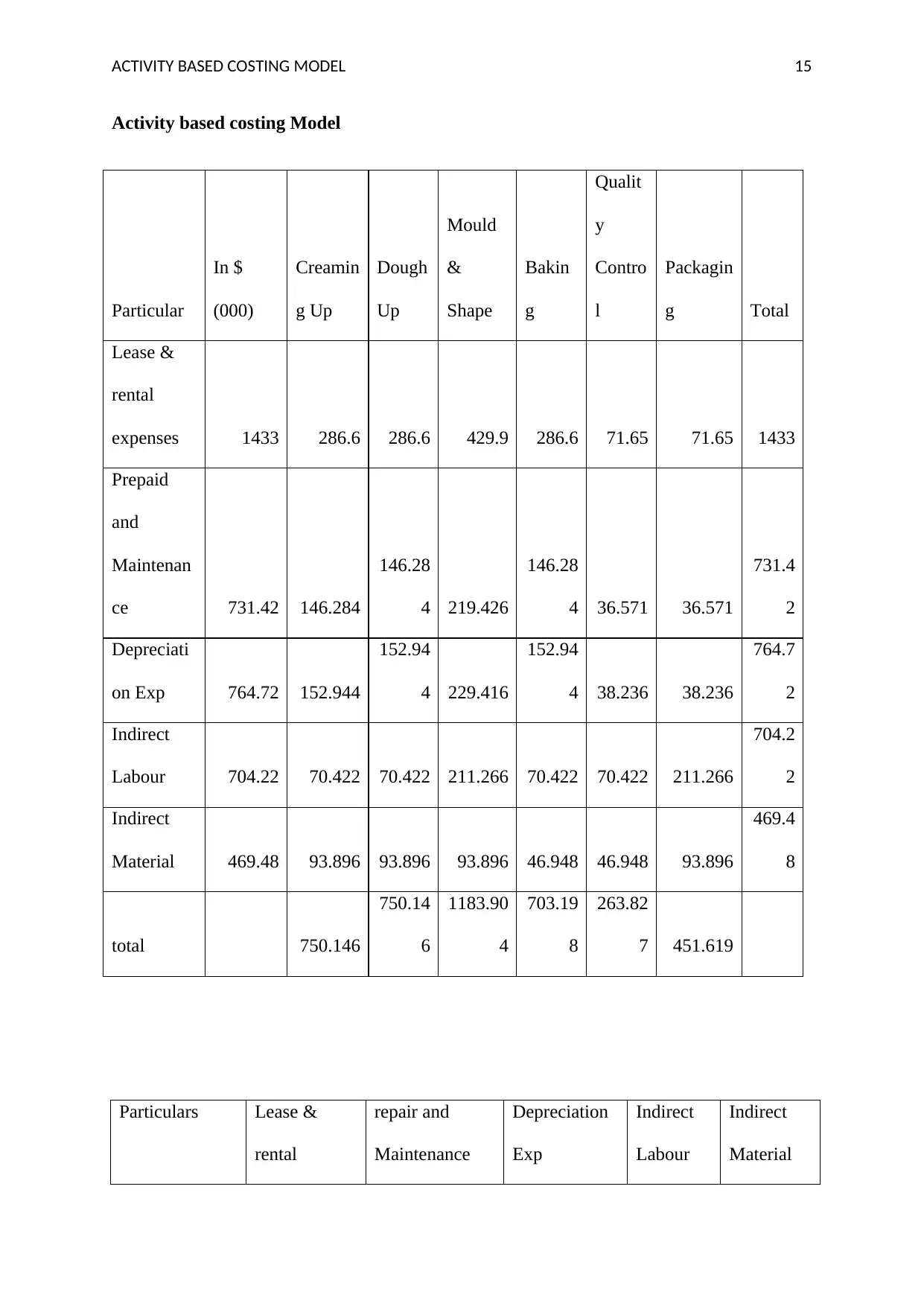
ACTIVITY BASED COSTING MODEL 15
Activity based costing Model
Particular
In $
(000)
Creamin
g Up
Dough
Up
Mould
&
Shape
Bakin
g
Qualit
y
Contro
l
Packagin
g Total
Lease &
rental
expenses 1433 286.6 286.6 429.9 286.6 71.65 71.65 1433
Prepaid
and
Maintenan
ce 731.42 146.284
146.28
4 219.426
146.28
4 36.571 36.571
731.4
2
Depreciati
on Exp 764.72 152.944
152.94
4 229.416
152.94
4 38.236 38.236
764.7
2
Indirect
Labour 704.22 70.422 70.422 211.266 70.422 70.422 211.266
704.2
2
Indirect
Material 469.48 93.896 93.896 93.896 46.948 46.948 93.896
469.4
8
total 750.146
750.14
6
1183.90
4
703.19
8
263.82
7 451.619
Particulars Lease &
rental
repair and
Maintenance
Depreciation
Exp
Indirect
Labour
Indirect
Material
Activity based costing Model
Particular
In $
(000)
Creamin
g Up
Dough
Up
Mould
&
Shape
Bakin
g
Qualit
y
Contro
l
Packagin
g Total
Lease &
rental
expenses 1433 286.6 286.6 429.9 286.6 71.65 71.65 1433
Prepaid
and
Maintenan
ce 731.42 146.284
146.28
4 219.426
146.28
4 36.571 36.571
731.4
2
Depreciati
on Exp 764.72 152.944
152.94
4 229.416
152.94
4 38.236 38.236
764.7
2
Indirect
Labour 704.22 70.422 70.422 211.266 70.422 70.422 211.266
704.2
2
Indirect
Material 469.48 93.896 93.896 93.896 46.948 46.948 93.896
469.4
8
total 750.146
750.14
6
1183.90
4
703.19
8
263.82
7 451.619
Particulars Lease &
rental
repair and
Maintenance
Depreciation
Exp
Indirect
Labour
Indirect
Material
Paraphrase This Document
Need a fresh take? Get an instant paraphrase of this document with our AI Paraphraser
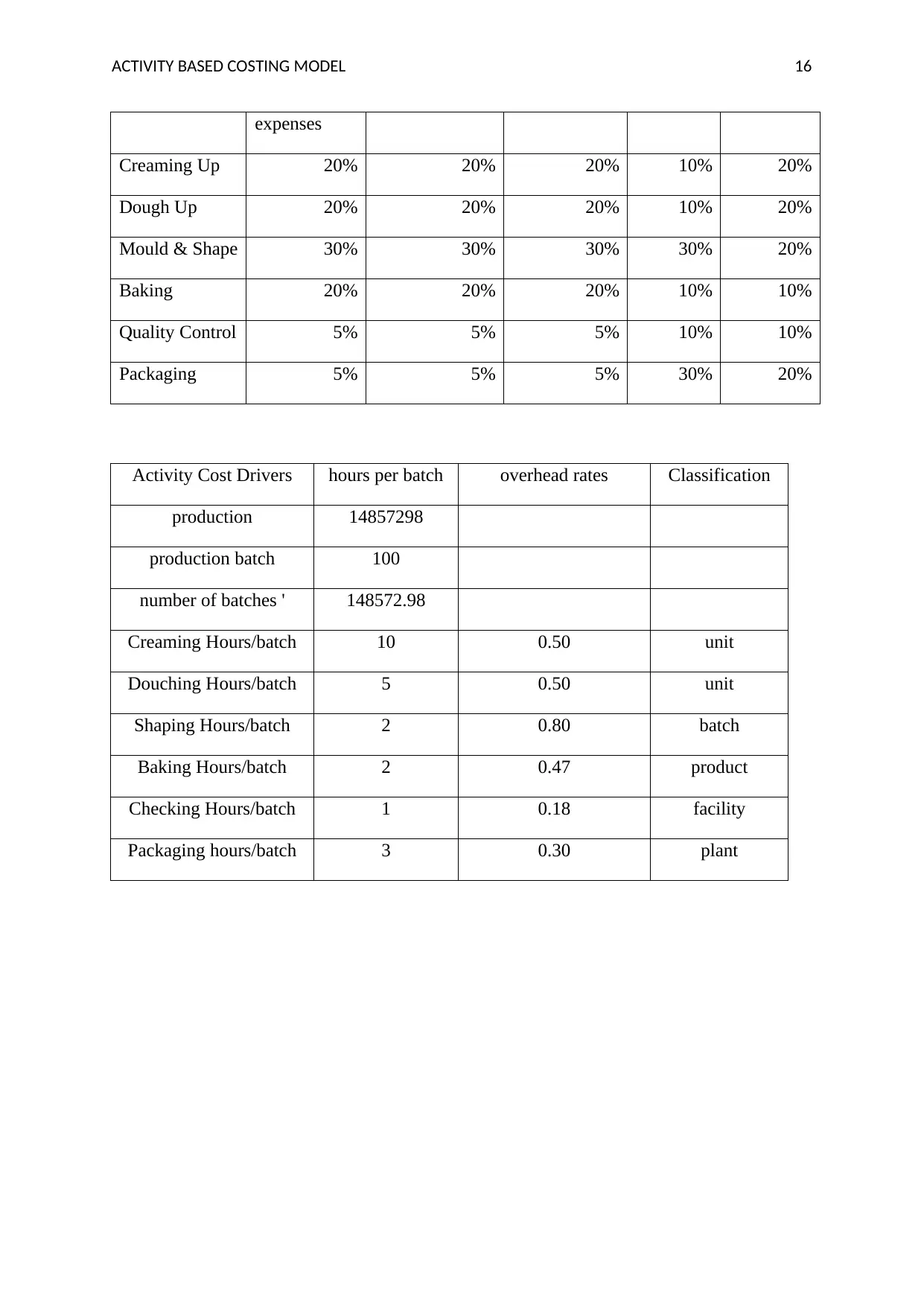
ACTIVITY BASED COSTING MODEL 16
expenses
Creaming Up 20% 20% 20% 10% 20%
Dough Up 20% 20% 20% 10% 20%
Mould & Shape 30% 30% 30% 30% 20%
Baking 20% 20% 20% 10% 10%
Quality Control 5% 5% 5% 10% 10%
Packaging 5% 5% 5% 30% 20%
Activity Cost Drivers hours per batch overhead rates Classification
production 14857298
production batch 100
number of batches ' 148572.98
Creaming Hours/batch 10 0.50 unit
Douching Hours/batch 5 0.50 unit
Shaping Hours/batch 2 0.80 batch
Baking Hours/batch 2 0.47 product
Checking Hours/batch 1 0.18 facility
Packaging hours/batch 3 0.30 plant
expenses
Creaming Up 20% 20% 20% 10% 20%
Dough Up 20% 20% 20% 10% 20%
Mould & Shape 30% 30% 30% 30% 20%
Baking 20% 20% 20% 10% 10%
Quality Control 5% 5% 5% 10% 10%
Packaging 5% 5% 5% 30% 20%
Activity Cost Drivers hours per batch overhead rates Classification
production 14857298
production batch 100
number of batches ' 148572.98
Creaming Hours/batch 10 0.50 unit
Douching Hours/batch 5 0.50 unit
Shaping Hours/batch 2 0.80 batch
Baking Hours/batch 2 0.47 product
Checking Hours/batch 1 0.18 facility
Packaging hours/batch 3 0.30 plant

ACTIVITY BASED COSTING MODEL 17
Particulars 2014 2015 2016 2017
Social Indcators 500 795 861 942
Environmental
Indicators 5% 7% 7% 10%
2014 2015 2016 2017
0
100
200
300
400
500
600
700
800
900
1000
0%
2%
4%
6%
8%
10%
12%
Chart Title
Years
Social
Social Indicators includes the communities
Environmental Indicators include the reduction of CO2 emissions from
manufacturing unit.
Answer to question no-C
After analysing all the social and environmental factors, it is observed that company
has programmed on-going educational efforts; enhanced teamwork and protocol of the
company have been able to improve the safety measures and performance each year for its
stakeholder. The production level and eco-support system have been strengthen due to the it’s
newly adopted environmental support program. Complying with the marketing and the
compliance policy the company is engaged in the number of global programs which have
increased the outcomes of the work in determined approach. In context with the negative
environmental factors, company has made efforts to reduce the CO emissions from
manufacturing by 15% and to sustain for a long period. In context with the packaging,
Company has made high investment to keep the pollution free packaging which will promote
its CSR activities program. In the area of the social responsibilities, employee development
Particulars 2014 2015 2016 2017
Social Indcators 500 795 861 942
Environmental
Indicators 5% 7% 7% 10%
2014 2015 2016 2017
0
100
200
300
400
500
600
700
800
900
1000
0%
2%
4%
6%
8%
10%
12%
Chart Title
Years
Social
Social Indicators includes the communities
Environmental Indicators include the reduction of CO2 emissions from
manufacturing unit.
Answer to question no-C
After analysing all the social and environmental factors, it is observed that company
has programmed on-going educational efforts; enhanced teamwork and protocol of the
company have been able to improve the safety measures and performance each year for its
stakeholder. The production level and eco-support system have been strengthen due to the it’s
newly adopted environmental support program. Complying with the marketing and the
compliance policy the company is engaged in the number of global programs which have
increased the outcomes of the work in determined approach. In context with the negative
environmental factors, company has made efforts to reduce the CO emissions from
manufacturing by 15% and to sustain for a long period. In context with the packaging,
Company has made high investment to keep the pollution free packaging which will promote
its CSR activities program. In the area of the social responsibilities, employee development
You're viewing a preview
Unlock full access by subscribing today!
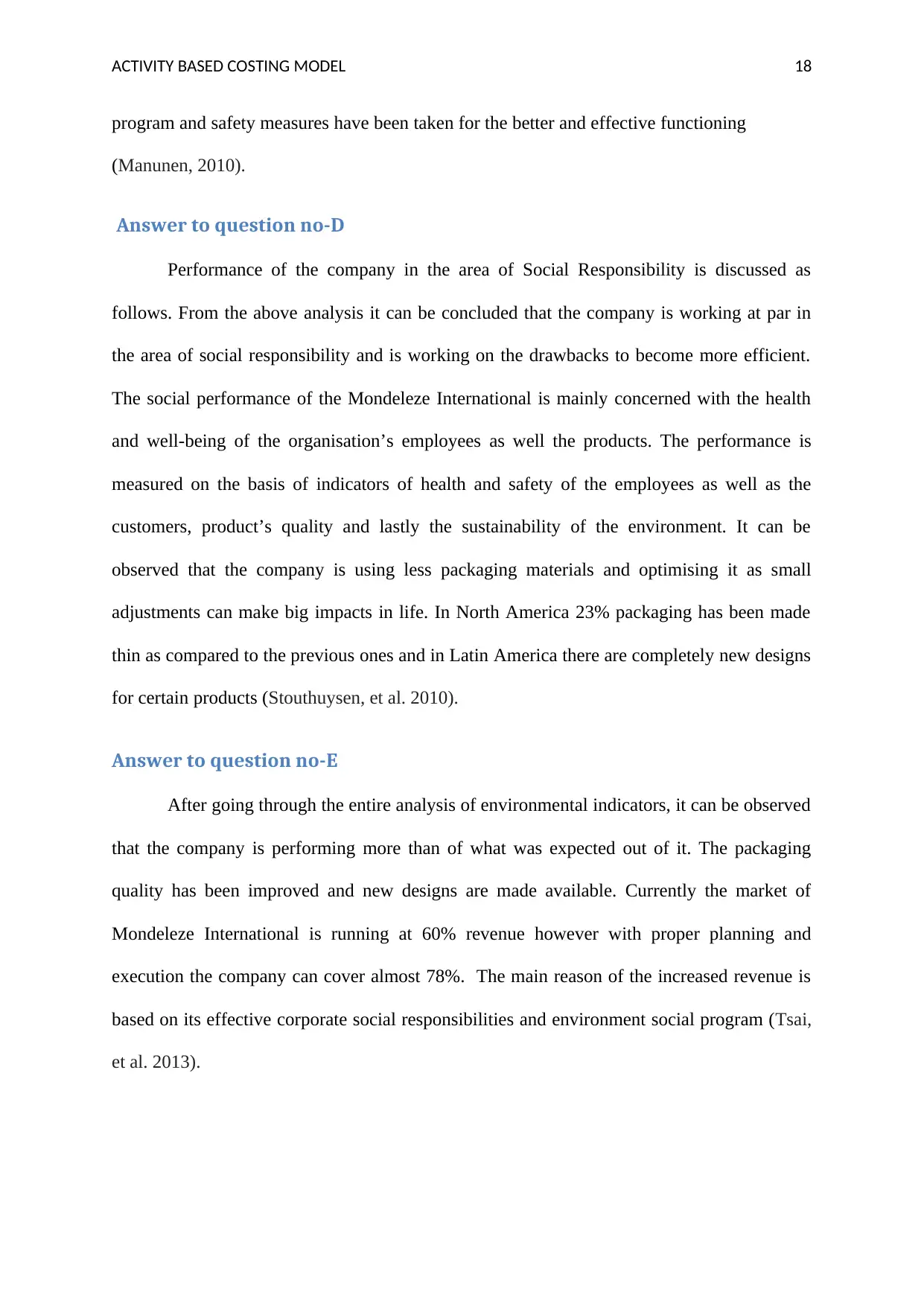
ACTIVITY BASED COSTING MODEL 18
program and safety measures have been taken for the better and effective functioning
(Manunen, 2010).
Answer to question no-D
Performance of the company in the area of Social Responsibility is discussed as
follows. From the above analysis it can be concluded that the company is working at par in
the area of social responsibility and is working on the drawbacks to become more efficient.
The social performance of the Mondeleze International is mainly concerned with the health
and well-being of the organisation’s employees as well the products. The performance is
measured on the basis of indicators of health and safety of the employees as well as the
customers, product’s quality and lastly the sustainability of the environment. It can be
observed that the company is using less packaging materials and optimising it as small
adjustments can make big impacts in life. In North America 23% packaging has been made
thin as compared to the previous ones and in Latin America there are completely new designs
for certain products (Stouthuysen, et al. 2010).
Answer to question no-E
After going through the entire analysis of environmental indicators, it can be observed
that the company is performing more than of what was expected out of it. The packaging
quality has been improved and new designs are made available. Currently the market of
Mondeleze International is running at 60% revenue however with proper planning and
execution the company can cover almost 78%. The main reason of the increased revenue is
based on its effective corporate social responsibilities and environment social program (Tsai,
et al. 2013).
program and safety measures have been taken for the better and effective functioning
(Manunen, 2010).
Answer to question no-D
Performance of the company in the area of Social Responsibility is discussed as
follows. From the above analysis it can be concluded that the company is working at par in
the area of social responsibility and is working on the drawbacks to become more efficient.
The social performance of the Mondeleze International is mainly concerned with the health
and well-being of the organisation’s employees as well the products. The performance is
measured on the basis of indicators of health and safety of the employees as well as the
customers, product’s quality and lastly the sustainability of the environment. It can be
observed that the company is using less packaging materials and optimising it as small
adjustments can make big impacts in life. In North America 23% packaging has been made
thin as compared to the previous ones and in Latin America there are completely new designs
for certain products (Stouthuysen, et al. 2010).
Answer to question no-E
After going through the entire analysis of environmental indicators, it can be observed
that the company is performing more than of what was expected out of it. The packaging
quality has been improved and new designs are made available. Currently the market of
Mondeleze International is running at 60% revenue however with proper planning and
execution the company can cover almost 78%. The main reason of the increased revenue is
based on its effective corporate social responsibilities and environment social program (Tsai,
et al. 2013).
Paraphrase This Document
Need a fresh take? Get an instant paraphrase of this document with our AI Paraphraser
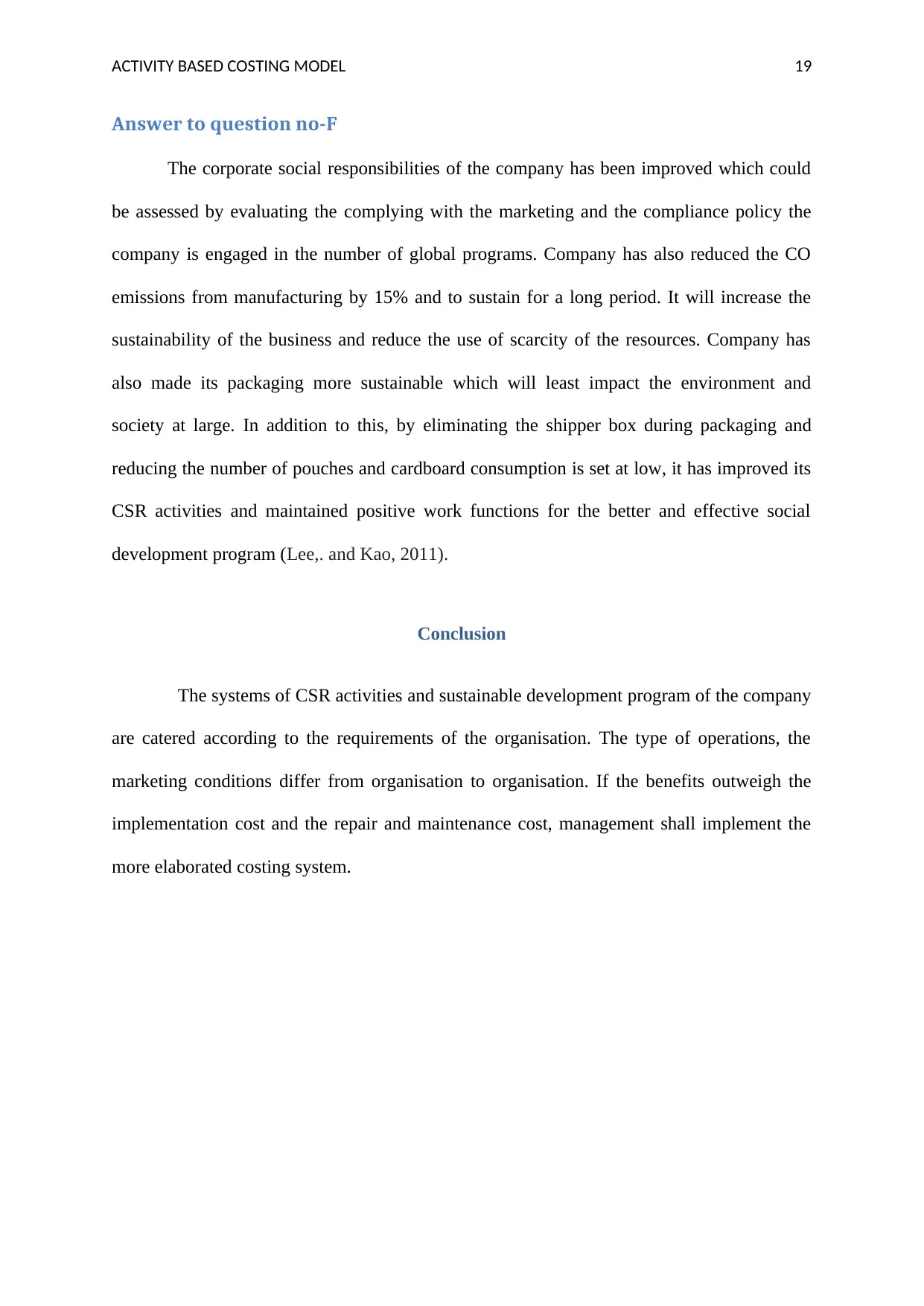
ACTIVITY BASED COSTING MODEL 19
Answer to question no-F
The corporate social responsibilities of the company has been improved which could
be assessed by evaluating the complying with the marketing and the compliance policy the
company is engaged in the number of global programs. Company has also reduced the CO
emissions from manufacturing by 15% and to sustain for a long period. It will increase the
sustainability of the business and reduce the use of scarcity of the resources. Company has
also made its packaging more sustainable which will least impact the environment and
society at large. In addition to this, by eliminating the shipper box during packaging and
reducing the number of pouches and cardboard consumption is set at low, it has improved its
CSR activities and maintained positive work functions for the better and effective social
development program (Lee,. and Kao, 2011).
Conclusion
The systems of CSR activities and sustainable development program of the company
are catered according to the requirements of the organisation. The type of operations, the
marketing conditions differ from organisation to organisation. If the benefits outweigh the
implementation cost and the repair and maintenance cost, management shall implement the
more elaborated costing system.
Answer to question no-F
The corporate social responsibilities of the company has been improved which could
be assessed by evaluating the complying with the marketing and the compliance policy the
company is engaged in the number of global programs. Company has also reduced the CO
emissions from manufacturing by 15% and to sustain for a long period. It will increase the
sustainability of the business and reduce the use of scarcity of the resources. Company has
also made its packaging more sustainable which will least impact the environment and
society at large. In addition to this, by eliminating the shipper box during packaging and
reducing the number of pouches and cardboard consumption is set at low, it has improved its
CSR activities and maintained positive work functions for the better and effective social
development program (Lee,. and Kao, 2011).
Conclusion
The systems of CSR activities and sustainable development program of the company
are catered according to the requirements of the organisation. The type of operations, the
marketing conditions differ from organisation to organisation. If the benefits outweigh the
implementation cost and the repair and maintenance cost, management shall implement the
more elaborated costing system.
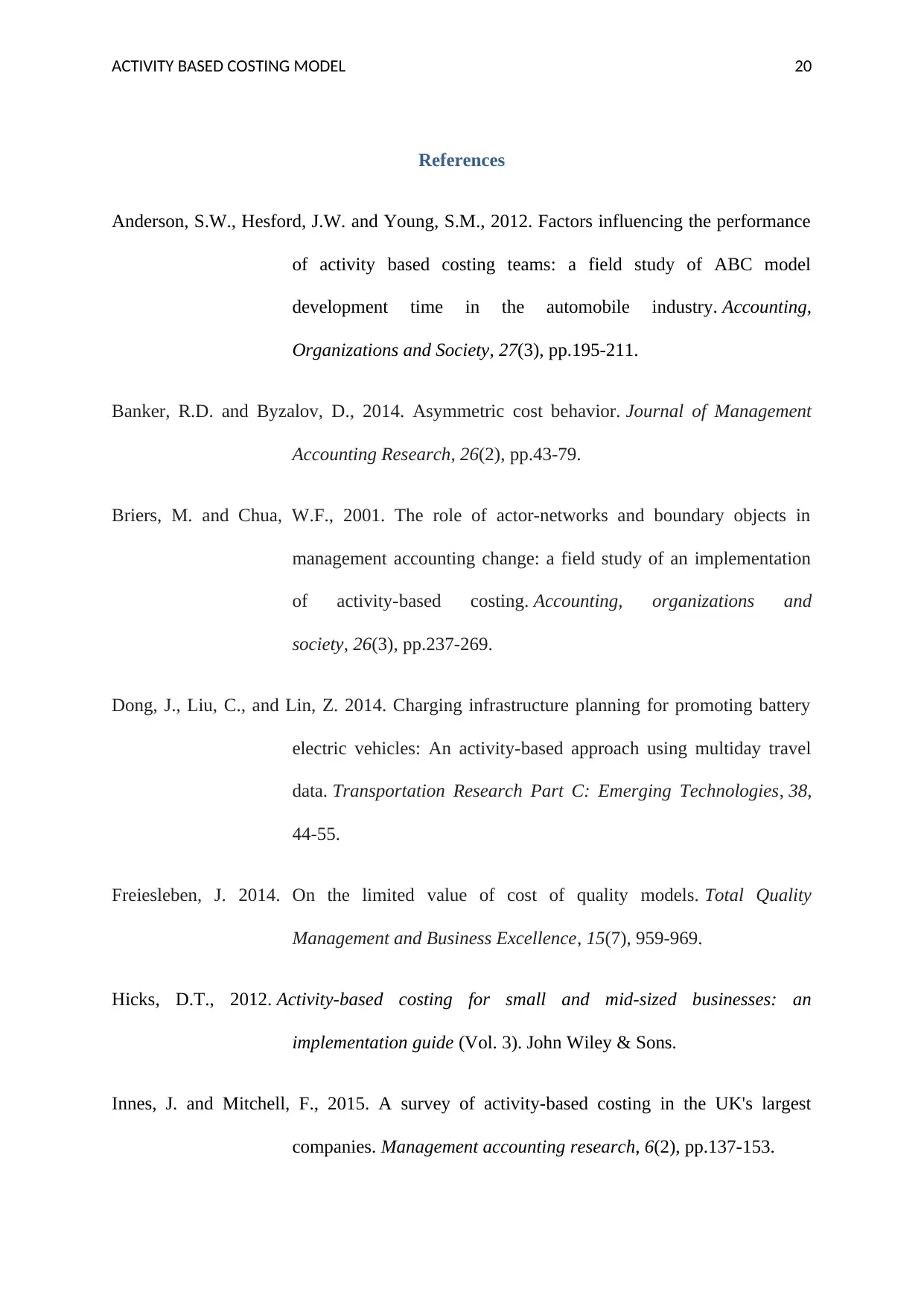
ACTIVITY BASED COSTING MODEL 20
References
Anderson, S.W., Hesford, J.W. and Young, S.M., 2012. Factors influencing the performance
of activity based costing teams: a field study of ABC model
development time in the automobile industry. Accounting,
Organizations and Society, 27(3), pp.195-211.
Banker, R.D. and Byzalov, D., 2014. Asymmetric cost behavior. Journal of Management
Accounting Research, 26(2), pp.43-79.
Briers, M. and Chua, W.F., 2001. The role of actor-networks and boundary objects in
management accounting change: a field study of an implementation
of activity-based costing. Accounting, organizations and
society, 26(3), pp.237-269.
Dong, J., Liu, C., and Lin, Z. 2014. Charging infrastructure planning for promoting battery
electric vehicles: An activity-based approach using multiday travel
data. Transportation Research Part C: Emerging Technologies, 38,
44-55.
Freiesleben, J. 2014. On the limited value of cost of quality models. Total Quality
Management and Business Excellence, 15(7), 959-969.
Hicks, D.T., 2012. Activity-based costing for small and mid-sized businesses: an
implementation guide (Vol. 3). John Wiley & Sons.
Innes, J. and Mitchell, F., 2015. A survey of activity-based costing in the UK's largest
companies. Management accounting research, 6(2), pp.137-153.
References
Anderson, S.W., Hesford, J.W. and Young, S.M., 2012. Factors influencing the performance
of activity based costing teams: a field study of ABC model
development time in the automobile industry. Accounting,
Organizations and Society, 27(3), pp.195-211.
Banker, R.D. and Byzalov, D., 2014. Asymmetric cost behavior. Journal of Management
Accounting Research, 26(2), pp.43-79.
Briers, M. and Chua, W.F., 2001. The role of actor-networks and boundary objects in
management accounting change: a field study of an implementation
of activity-based costing. Accounting, organizations and
society, 26(3), pp.237-269.
Dong, J., Liu, C., and Lin, Z. 2014. Charging infrastructure planning for promoting battery
electric vehicles: An activity-based approach using multiday travel
data. Transportation Research Part C: Emerging Technologies, 38,
44-55.
Freiesleben, J. 2014. On the limited value of cost of quality models. Total Quality
Management and Business Excellence, 15(7), 959-969.
Hicks, D.T., 2012. Activity-based costing for small and mid-sized businesses: an
implementation guide (Vol. 3). John Wiley & Sons.
Innes, J. and Mitchell, F., 2015. A survey of activity-based costing in the UK's largest
companies. Management accounting research, 6(2), pp.137-153.
You're viewing a preview
Unlock full access by subscribing today!
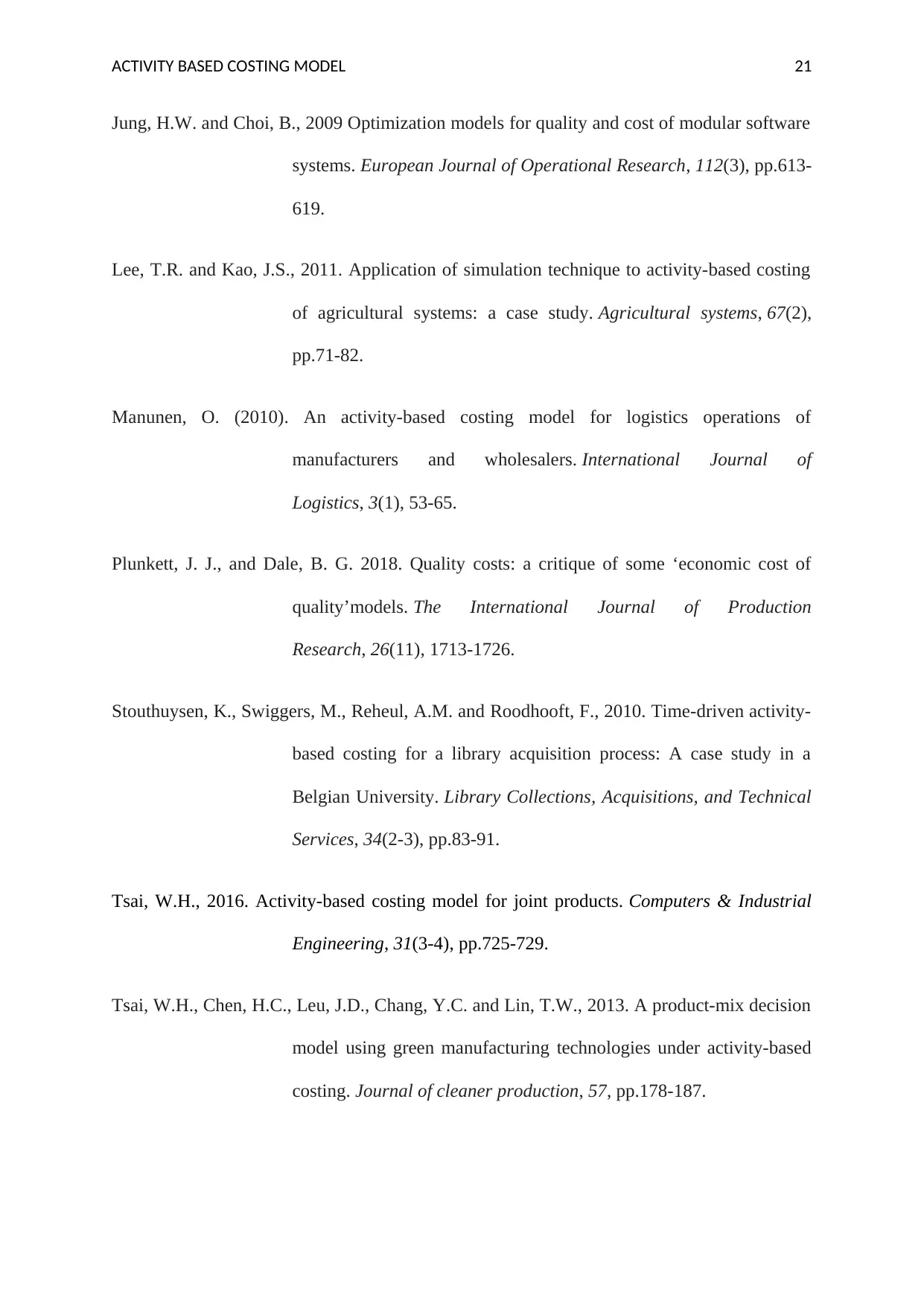
ACTIVITY BASED COSTING MODEL 21
Jung, H.W. and Choi, B., 2009 Optimization models for quality and cost of modular software
systems. European Journal of Operational Research, 112(3), pp.613-
619.
Lee, T.R. and Kao, J.S., 2011. Application of simulation technique to activity-based costing
of agricultural systems: a case study. Agricultural systems, 67(2),
pp.71-82.
Manunen, O. (2010). An activity-based costing model for logistics operations of
manufacturers and wholesalers. International Journal of
Logistics, 3(1), 53-65.
Plunkett, J. J., and Dale, B. G. 2018. Quality costs: a critique of some ‘economic cost of
quality’models. The International Journal of Production
Research, 26(11), 1713-1726.
Stouthuysen, K., Swiggers, M., Reheul, A.M. and Roodhooft, F., 2010. Time-driven activity-
based costing for a library acquisition process: A case study in a
Belgian University. Library Collections, Acquisitions, and Technical
Services, 34(2-3), pp.83-91.
Tsai, W.H., 2016. Activity-based costing model for joint products. Computers & Industrial
Engineering, 31(3-4), pp.725-729.
Tsai, W.H., Chen, H.C., Leu, J.D., Chang, Y.C. and Lin, T.W., 2013. A product-mix decision
model using green manufacturing technologies under activity-based
costing. Journal of cleaner production, 57, pp.178-187.
Jung, H.W. and Choi, B., 2009 Optimization models for quality and cost of modular software
systems. European Journal of Operational Research, 112(3), pp.613-
619.
Lee, T.R. and Kao, J.S., 2011. Application of simulation technique to activity-based costing
of agricultural systems: a case study. Agricultural systems, 67(2),
pp.71-82.
Manunen, O. (2010). An activity-based costing model for logistics operations of
manufacturers and wholesalers. International Journal of
Logistics, 3(1), 53-65.
Plunkett, J. J., and Dale, B. G. 2018. Quality costs: a critique of some ‘economic cost of
quality’models. The International Journal of Production
Research, 26(11), 1713-1726.
Stouthuysen, K., Swiggers, M., Reheul, A.M. and Roodhooft, F., 2010. Time-driven activity-
based costing for a library acquisition process: A case study in a
Belgian University. Library Collections, Acquisitions, and Technical
Services, 34(2-3), pp.83-91.
Tsai, W.H., 2016. Activity-based costing model for joint products. Computers & Industrial
Engineering, 31(3-4), pp.725-729.
Tsai, W.H., Chen, H.C., Leu, J.D., Chang, Y.C. and Lin, T.W., 2013. A product-mix decision
model using green manufacturing technologies under activity-based
costing. Journal of cleaner production, 57, pp.178-187.
1 out of 22
Related Documents
Your All-in-One AI-Powered Toolkit for Academic Success.
+13062052269
info@desklib.com
Available 24*7 on WhatsApp / Email
![[object Object]](/_next/static/media/star-bottom.7253800d.svg)
Unlock your academic potential
© 2024 | Zucol Services PVT LTD | All rights reserved.





